#named after one of the most influential movie stars of the 20th century
Text
sometimes i pull my life size skeleton out of his coffin and i set him up in the house b4 i go to bed so that the others can find him when they wake up
#spikes rambles#his name is skeleton btw#named after one of the most influential movie stars of the 20th century#skeleton#who played the most iconic roll in one of the best known films ever made#skeleton. in the 1959 classic house on haunted hill which also had some dude named vincent? idk
20 notes
·
View notes
Text
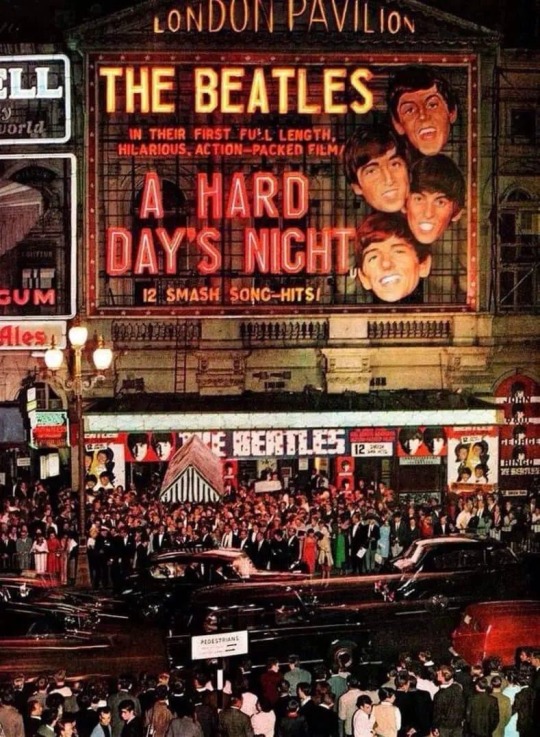
July 6, 1964 - The Beatles' first feature film, A Hard Day's Night, had its première at the London Pavilion.
A Hard Day's Night is a 1964 British musical comedy film directed by Richard Lester and starring the Beatles—John Lennon, Paul McCartney, George Harrison, and Ringo Starr—during the height of Beatlemania. It was written by Alun Owen and originally released by United Artists. The film portrays 36 hours in the lives of the group.
The film was a financial and critical success. Forty years after its release, Time magazine rated it as one of the all-time great 100 films. In 1997, British critic Leslie Halliwell described it as a "comic fantasia with music; an enormous commercial success with the director trying every cinematic gag in the book" and awarded it a full four stars.[The film is credited as being one of the most influential of all musical films, inspiring numerous spy films, the Monkees' television show and pop music videos. In 1999, the British Film Institute ranked it the 88th greatest British film of the 20th century.
The movie's strange title originated from something said by Ringo Starr, who described it this way in an interview with disc jockey Dave Hull in 1964: "We went to do a job, and we'd worked all day and we happened to work all night. I came up still thinking it was day I suppose, and I said, 'It's been a hard day ...' and I looked around and saw it was dark so I said, '... night!' So we came to A Hard Day's Night."
PLOT
Bound for a London show from Liverpool, the Beatles escape a horde of fans ("A Hard Day's Night"). Once they are aboard the train and trying to relax, various interruptions test their patience: after a dalliance with a female passenger, Paul's grandfather is confined to the guard's van and the four lads join him there to keep him company. John Lennon, Paul McCartney, George Harrison, and Ringo Starr play a card game, entertaining some schoolgirls before arriving at their desired destination ("I Should Have Known Better").
Upon arrival in London, the Beatles are driven to a hotel, only to feel trapped inside. They are tasked to answer numerous letters and fan mail in their hotel room but instead, they sneak out to party ("I Wanna Be Your Man", "Don't Bother Me", "All My Loving"). After being caught by their manager Norm (Norman Rossington), they return to find out that Paul's grandfather John (Wilfrid Brambell) went to the casino. After causing minor trouble at the casino, the group is taken to the theatre where their performance is to be televised. After rehearsals ("If I Fell"), the boys leave through a fire escape and dance around a field but are forced to leave by the owner of the property ("Can't Buy Me Love"). On their way back to the theatre, they are separated when a woman named Millie (Anna Quayle) recognizes John as someone famous but cannot recall who he is. George is also mistaken for an actor auditioning for a television show featuring a trendsetter hostess. The boys all return to rehearse another song ("And I Love Her") and after goofing around backstage, they play another song to impress the makeup artists ("I'm Happy Just to Dance with You").
While waiting to perform, Ringo is forced to look after Paul's grandfather and decides to spend some time alone reading a book. Paul's grandfather, a "villain, a real mixer", convinces him to go outside to experience life rather than reading books. Ringo goes off by himself ("This Boy" instrumental). He tries to have a quiet drink in a pub, takes pictures, walks alongside a canal, and rides a bicycle along a railway station platform. While the rest of the band frantically and unsuccessfully attempts to find Ringo, he is arrested for acting in a suspicious manner. Paul's grandfather joins him shortly after attempting to sell photographs wherein he forged the boys' signatures. Paul's grandfather eventually makes a run for it and tells the rest of the band where Ringo is. The boys all go to the station to rescue Ringo but end up running away from the police back to the theatre ("Can't Buy Me Love") and the concert goes ahead as planned. After the concert ("Tell Me Why", "If I Fell", "I Should Have Known Better", "She Loves You"), the band is taken away from the hordes of fans via helicopter.
From beatlesbible:
The première was attended by The Beatles and their wives and girlfriends, and a host of important guests including Princess Margaret and Lord Snowdon. Nearby Piccadilly Circus was closed to traffic as 12,000 fans jostled for a glimpse of the group.
“I remember Piccadilly being completely filled. We thought we would just show up in our limo, but it couldn't get through for all the people. It wasn't frightening - we never seemed to get worried by crowds. It always appeared to be a friendly crowd; there never seemed to be a violent face.”
~ Paul McCartney, Anthology
It was a charity event held in support of the Variety Club Heart Fund and the Docklands Settlements, and the most expensive tickets cost 15 guineas (£15.75).
After the screening The Beatles, the royal party and other guests including The Rolling Stones enjoyed a champagne supper party at the Dorchester Hotel, after which some of them adjourned to the Ad Lib Club until the early hours of the morning.
9 notes
·
View notes
Text
Dolores del Rio - Hollywood's First Latin Superstar



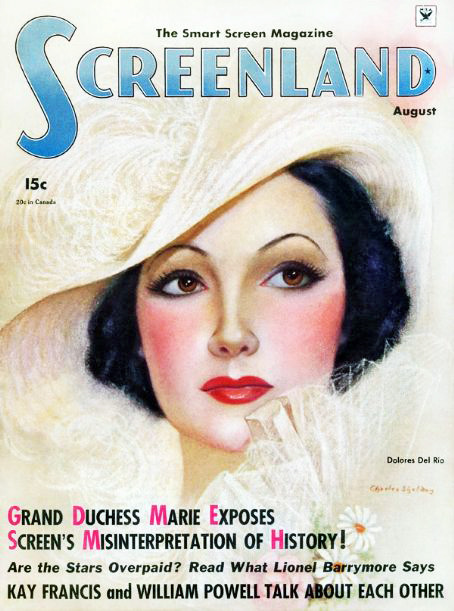
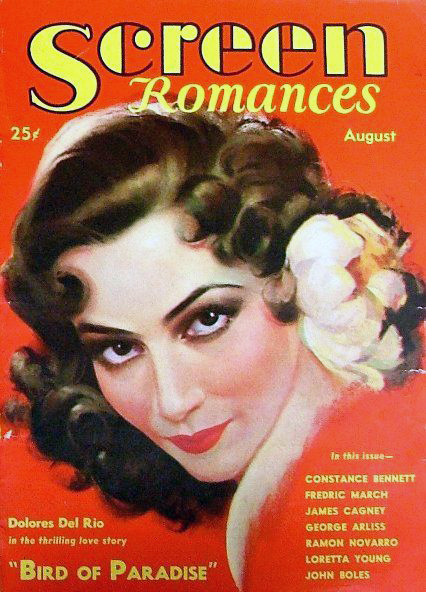
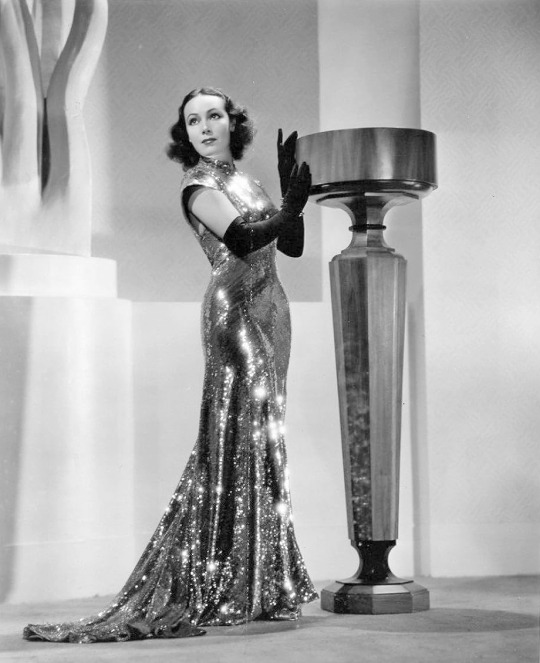
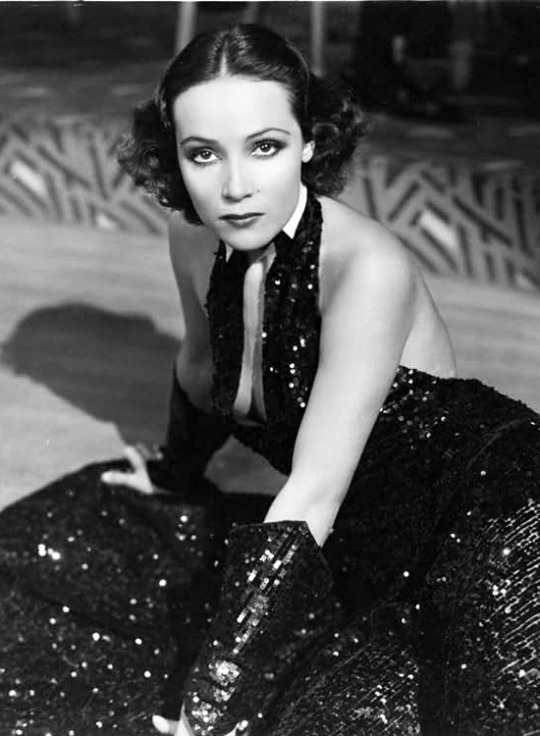
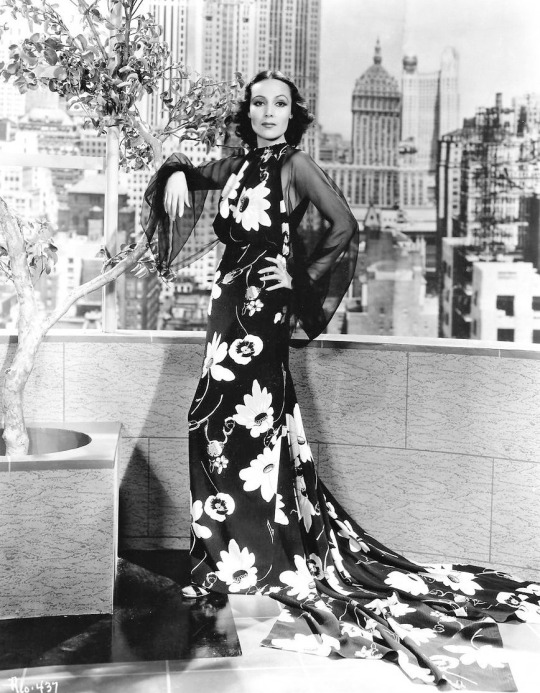
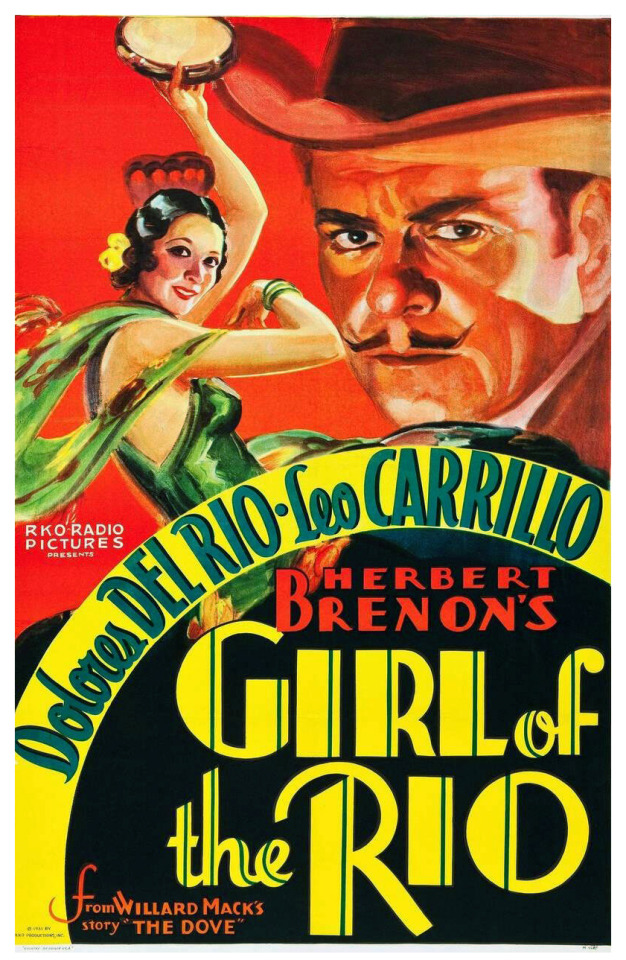
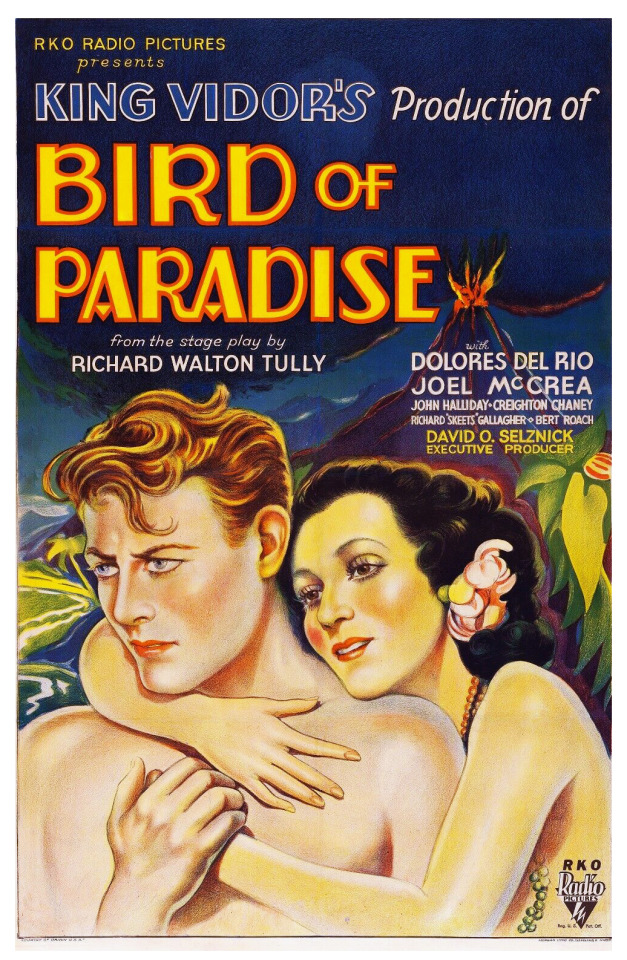
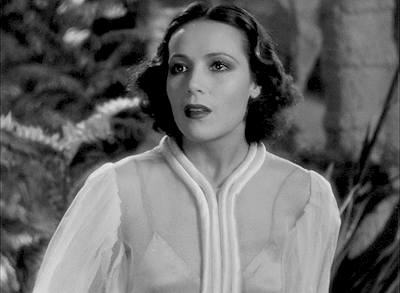

María de los Dolores Asúnsolo y López Negrete (born in Victoria de Durango, Durango on 3 August 1904), known professionally as Dolores del Río, was a Mexican actress whose career spanned more than 50 years. With her meteoric career in the 1920s/1930s Hollywood and great beauty, she is regarded as "Hollywood's First Latin Superstar."
Del Rio came from an aristocratic Mexican family whose lineage went back to Spain and the viceregal nobility. Her family lost all its assets during the Mexican Revolution. She developed a great taste for dance at a young age, which awakened in her when her mother took her to one of the performances of the Russian dancer Ana Pavlova.
In 1925, she met American filmmaker Edwin Carewe, an influential director at First National Pictures, who was in Mexico at the time. He convinced her to move to Hollywood. After a couple of years, United Artists became interested in her and signed her to a contract. Her career blossomed at the studio, and she made memorable films such as Ramona (1928) and Evangeline (1929). After her contract was terminated, she was hired by RKO Pictures ,then Warner Bros, and then 20th Century Fox.
Unfortunately, Latin stars had less opportunities in Hollywood then, and her career declined. She returned to her birth country, where she became one of the most important female figures in the Golden Age of Mexican cinema.
Del Río returned to Hollywood and made movies and TV shows. However, she continued to produce and star in Mexico in film and theater projects.
She died from liver failure at the age of 78 in Newport Beach, California. Her remains have been interred in the Rotonda de las Personas Ilustres in Mexico City since 2005.
Legacy:
Won the Silver Ariel Award (Mexican equivalent to the Oscars) for Best Actress three times: Las Abandonadas (1946), Doña Perfecta (1951), and El Niño y la niebla (1953); and was nominated two more times: La Otra (1946) and La Casa Chica (1949)
Awarded the Best Actress by the Instituto de Artes y Ciencias Cinematográficas de Mexico for Flor Silvestre (1943)
Named as one of the WAMPAS Baby Stars of 1926
Was the model of the statue of Evangeline in 1929 located in St. Martinville, Louisiana
Honored as one of the best dressed woman in America with the Neiman Marcus Fashion Award in 1952
Received a medal for her outstanding scenic work abroad from the Asociacion Nacional de Actores in 1957
Selected as the first woman to sit on the Cannes Film Festival jury, and even served as the Vice President, in 1957
Co-founded the Sociedad Protectora del Tesoro Artistico de México, responsible for protecting art and culture in México, in 1966
Given the Diosa de Plata Award by the Mexican Film Journalists Association twice: in recognition her contribution to Mexican film industry in 1965 and in commemoration of her 50-year career in 1975
Presented with a medal for her cultural contribution to the peoples of America by the Organization of American States in 1967
Was honored by Instituto Nacional de Bellas Artes y Literatura and the Mexico's Screen Actors Guild in 1970 with a tribute titled Dolores del Rio in the Art, where her main portraits and a sculpture by Francisco Zúñiga were exhibited
Was a spokeswoman of UNICEF in Latin America in the 1970s
Received the Golden Ariel Honorific Award in 1975 for her contribution to Mexican cinema
Formed the union group "Rosa Mexicano", which provided a day nursery for the children of the members of the Mexican Actor's Guild in 1970
Helped found the Cultural Festival Cervantino in Guanajuato in 1972
Received the Mexican Legion of Honor in 1975
Received a diploma and a silver plaque for her work in cinema as a cultural ambassador by the Mexican Cultural Institute and the White House in 1978
Awarded the George Eastman Award, given by George Eastman House for distinguished contribution to the art of film in 1982
Has been the namesake of the Diosa de Plata (Dolores del Río) Award for the best dramatic female performance by the Periodistas Cinematográficos de México since 1983
Has murals painted on Hudson Avenue in Hollywood painted by the Mexican-American artist Alfredo de Batuc in 1990 and at Hollywood High School in 2002
Is the namesake of Teatro Dolores del Rio, built in 1992, in Durango
Chosen to be one of The Four Ladies of Hollywood, a sculpture at Hollywood-La Brea Boulevard in 1993
Realized a tribute by fashion designer John Galliano in his 1995 Fall/Winter collection, Dolores.
Stipulated that all her artworks be donated to the National Institute of Fine Arts and Literature of Mexico, for display in various museums in Mexico City, including the National Museum of Art, the Museum of Art Carillo Gil and the Diego Rivera & Frida Kahlo House-Studio
Included in a cameo in the Disney-Pixar animated movie Coco in 2017
Honored in three monuments in Mexico City: a statue located in the second section of Chapultepec Park, a bust located in the Parque Hundido, and another bust in the nursery that bears her name.
Honored with two streets named after her: Blvd. Dolores del Río, in Durango, Mexico, her hometown and Dolores del Rio Ave. in Mission, Texas
Honored with a Google Doodle on her 113th birthday in 2017
Has her star on the Hollywood Walk of Fame at 1630 Vine Street for motion picture

#Dolores Del Rio#Evangeline#Mexico#Latin#Latina#Hollywood's First Latin Superstar#Latin Actress#Mexican Actress#Mexicana#Silent Films#Silent Movies#Silent Era#Silent Film Stars#Golden Age of Hollywood#Classic Hollywood#Film Classics#Classic Films#Old Hollywood#Vintage Hollywood#Hollywood#Movie Star#Hollywood Walk of Fame#Walk of Fame#Movie Legends#Actress#hollywood actresses#hollywood icons#hollywood legend#movie stars#1900s
7 notes
·
View notes
Text

The Robe (1953)
Henry Koster’s The Robe, distributed by 20th Century Fox, appeared near the beginning of an era where religious epics and sword-and-sandal films became massive box office draws worldwide. Cecil B. DeMille’s Samson and Delilah (1949) and Mervyn LeRoy’s Quo Vadis (1951) had already laid the foundation on which Koster’s film, adapting Lloyd C. Douglas’ novel of the same name, would find its success. Despite The Robe being highly influential in Hollywood and becoming the highest-grossing film of 1953, the likes of DeMille’s The Ten Commandments (1956) and William Wyler’s Ben-Hur (1959) overtook it artistically and financially – no shame there, as those are two far superior films.
So what is The Robe’s claim to movie history beyond its initial theatrical earnings? When The Robe first came to theaters, 20th Century Fox advertised it as the first film ever made in CinemaScope. Created by Fox’s president, Spyros P. Skouras, CinemaScope was a format in which a widescreen camera lens contracted its widescreen shots onto regular 35mm film and, during theatrical projection, another lens would de-contract the image from the 35mm film in order to project a widescreen format. Theaters would only need to make minor, inexpensive modifications to their projectors in order to show a film in true CinemaScope, a 2:55:1 widescreen aspect ratio. Almost all other films were shot in the Academy ratio at the time (1.37:1, close to the 4:3 ratio – think: black bars on the left- and right-hand sides of a widescreen monitor – seen on many older standard computer monitors and televisions). With increasing competition from television, Fox executives believed CinemaScope could be a way to lure audiences back into theaters. Despite this overreaction from Fox’s executives (as well as the other major Hollywood studios), the legacy of CinemaScope’s innovation is still apparent today. Seven decades later, widescreen formats, not the Academy ratio, are the default in film and television.
Walking through the markets of Rome, returning Roman Empire tribune Marcellus Gallio (Richard Burton) reunites with his childhood sweetheart, Diana (Jean Simmons), who is now promised to Marcellus’ rival, Caligula (an always-sneering Jay Robison). Not long after, Marcellus – out of pettiness rather than financial sense – outbids Caligula for the Greek slave, Demetrius (Victor Mature). Marcellus immediately frees Demetrius, but Demetrius thinks of himself as honor-bound to stay by Marcellus. Elsewhere, an incensed Caligula reassigns Marcellus to Palestine – which, to the film’s Roman characters, might as well be the armpit of the Roman Empire. Marcellus and Demetrius go to Jerusalem, where they witness a man named Jesus enter the city, heralded by crowds of Jews greeting him with palms. Several days later, Judean Governor Pontius Pilate (Richard Boone) orders Marcellus to crucify Jesus on Calvary. Marcellus executes the order but, during and after the crucifixion, witnesses and experiences supernatural events. Demetrius, who has become a follower of Jesus during that week, obeys Marcellus when he asks him to fetch Jesus’ robe. The moment Marcellus dons the robe, he suffers something like a seizure. He falls out with Demetrius, and spends the rest of the film reckoning with his conscience over his role in Jesus’ crucifixion.
The film also stars Michael Rennie as Peter, Dean Jagger as Justus, Torin Thatcher as Senator Gallio, and Ernest Thesiger as Emperor Tiberius. Michael Ansara and Donald C. Klune are both uncredited as Judas Iscariot and Jesus, respectively.
The Robe has the misfortune of peaking in the first half. The adapted screenplay from Gina Kaus (1949’s The Red Danube), Albert Maltz (one of the blacklisted Hollywood Ten; 1950’s Broken Arrow), and Philip Dunne (1941’s How Green Was My Valley) is at its most interesting whenever Marcellus and Demetrius find themselves at odds with the other. In the scenes they share together, that happens often. But when Demetrius disappears after their disagreement over Jesus’ robe midway through, the film begins to sag with no foil for Burton to play off of.
For the entirety of this film, Richard Burton’s acting is overwrought. Burton, who had just arrived in Hollywood the year before to star in My Cousin Rachel (1952), is leaning too deeply into his theatrical roots here. His grandiose exclamations, stiff facial acting, and inconsistent line delivery result in a performance that is easily the weakest part of this film (Jean Simmons is also guilty, to a far lesser degree, of these same flaws in her performance). The Robe requires Burton’s Marcellus to undergo a spiritual conversion – becoming an adherent of Jesus despite following orders to crucify him, a developmental arc more dramatic than any other character’s in this film. Burton’s inability to convincingly sell this conversion (the stoic masculine tension, which some will interpret as coded homosexuality, between Burton’s Marcellus and Mature’s Demetrius does not help) weakens the film’s spiritual power.
Instead, it is Mature who is The Robe’s reliable scene-stealer. Mature, at one time likened to a “miniature Johnny Weissmuller”, has the classical Greek physique that, frankly, Burton does not. And in contrast to Burton at this time in their careers, Mature was more capable of a nuanced performance, as evidenced in his roles as Doc Holliday in My Darling Clementine (1946) and Nick Bianco in Kiss of Death (1947). As Demetrius, his soul hardened through his enslavement, there remains hope for a life free from the yoke of the Roman Empire and its callous slave masters. One sees it in his face during Holy Week, culminating with seeing Jesus dying on the cross. His faith is there, too, during a torture scene upon his return to Rome and an encounter with Peter. Amid miracles and cruelties, Mature’s Demetrius is simply the most compelling character of The Robe and the viewer – through Mature’s performance, especially in contrast to those of Jean Simmons and Richard Burton’s – can discern his genuine turn of faith. The Robe’s failure to showcase this inner awakening more believably is the fault of its two central actors and its screenplay; Mature’s performance and Demetrius’ characterization are all that saves the narrative.
One aspect of Christianity that The Robe captures confusingly (and oxymoronically) is the insignificance of Judea and the prominence of early Christianity in Rome in the time immediately following Jesus’ crucifixion. Oftentimes in Biblical epics, Judea is a centerpiece of the Roman Empire when, in truth (and in The Robe), it was a relative backwater. By Caligula’s reign between 37 and 41 CE, Christianity almost certainly would not have had a substantial presence in Rome at that time. So while Caligula would probably see Christianity as a threat, the film’s decision to treat the early Christians as a clear and present danger to his rule and the Roman state religion is the film’s glaring historical inaccuracy. The Robe – the book and the film – muddies the timeline from Jesus’ crucifixion to the film’s final scene in Caligula’s court. The relative suddenness of the Roman Empire seeing the early Christians as a very minor cult into becoming an Empire-wide menace is difficult to reconcile.
With few other post-silent film era Biblical epics as a guide, The Robe helps set the aesthetic of its fellow Biblical epics and sword-and-sandals movies going forward through its costumes and production design. The work of costume designers Charles LeMaire (1950’s All About Eve, 1956’s Carousel) and Emile Santiago (1952’s Androcles and the Lion, 1958’s The Big Country) is resplendent, regardless of either the Roman or Judean setting. Art directors Lyle R. Wheeler (1939’s Gone with the Wind, 1956’s The King and I) and George Davis (All About Eve, 1963’s How the West Was Won) and set decorators Walter M. Scott (All About Eve, 1965’s The Sound of Music) and Paul S. Fox (The King and I, 1963’s Cleopatra) all make full use of the CinemaScope format and color to enliven the scenery – a sumptuous visual treat for the viewer, and, to reiterate, setting a standard that the crew of The Ten Commandments and Ben-Hur both would study and surpass.
Of all of 20th Century Fox contracted stalwarts behind the camera, composer Alfred Newman was the studio’s most important figure. If Fox’s executives needed a composer to craft a score for what they would consider would be their prestige motion picture of the year, Newman – who composed the original 20th Century Fox fanfare and its CinemaScope extension (the extension, which is now inextricable from the fanfare, was first introduced in 1954’s River of No Return) – was almost always their first choice.
youtube
In one of Newman’s finest scores of his career, it is his choral compositions, with incredible help from his longtime choral supervisor Ken Darby, that form the score’s emotive spine. Jesus’ motif, shared between wordless choir and strings, appears almost immediately, in the opening seconds of the “Prelude”. During the many invocations of a Messiah before Jesus’ first physical appearance in The Robe, his motif shifts, changes form, and modulates – imparting not spiritual comfort or devotion, but a mysteriousness and otherworldliness. When Jesus (whose face we never see) first appears in Jerusalem on Palm Sunday, the cue “Passover/Palm Sunday” represents one of the rare juxtapositions of the brass-heavy martial music representing the Roman presence in Judea and Jesus himself. The modulation to a major key at 1:22 in this cue, with festive percussion, also includes one of the only instances of celebratory choral music in the score. Jesus’ motif in “Passover/Palm Sunday”, appears at 2:26 – cementing his (and Christianity’s) association with the cue, and appearing as the only instance in which one might consider this motif triumphant.
Choruses, which Western viewers so often associate in religious movies as angelic musical devices, become mournful in “The Crucifixion” – arguably the standout cue of Newman’s score. Even though one might be well aware of Jesus’ death and can anticipate a turn in the music (starting moments earlier in “The Carriage of the Cross”), it is startling to hear Newman’s composition change so rapidly. But it is in these several minutes depicting Jesus’ final moments that Newman, with modifications to his harmonies and orchestration, transforms Jesus’ motif to evoke its tragic dimensions. It is magnificent scoring from Newman, and this is not even mentioning his wonderful demarcation of Roman and Judean identities through his score.
In a film about faith – how it comforts, destroys, heals, and vexes – one wishes that the characterization of The Robe’s supposed lead characters in Marcellus and Diana could feel more plausible. The film’s final scene, possibly allegorizing of screenwriter Albert Maltz’s travails as a blacklisted figure in Hollywood, is decently powerful, but it needs far more storytelling support from numerous scenes preceding it.
As it is, the film’s expressive power lies within Demetrius and Victor Mature’s performance. So how fortunate that, because Fox also wanted to make a sequel to The Robe even before it finished production, Mature also signed a contract to appear in a sequel. Nine months after The Robe made its theatrical debut, Victor Mature starred in Demetrius and the Gladiators, directed by Delmer Daves and also seeing Michael Rennie and Jay Robinson reprise their roles as Peter and Caligula, respectively. Though it did not top the box office for that year like The Robe did, Demetrius and the Gladiators was a financial boon for Fox.
With Hollywood’s major studios always ready to respond to the box office successes of their rivals, The Robe helped make possible the decade of Biblical and sword-and-sandals epics to come – and the required viewings for many a Sunday School student in the years hence. These films were Studio System Hollywood in full maximalism, adopting human and tactile scales seldom seen today.
Yet outside of churchgoers, The Robe – for its CinemaScope and genre-specific innovations – has seen its standing slip gradually over the years, no thanks to the reputations of better movies of this tradition and, regrettably, decisions to keep 20th Century Fox’s valuable past under lock and key. 20th Century Fox’s refusal to distribute their classic films more often and more widely – before and after the studio’s 2019 takeover by the Walt Disney Company (and post-takeover, I believe the situation is now worse) – is resulting in films like The Robe slip through the proverbial cracks of film history, sights unseen for younger film buffs. That is unfortunate, especially as The Robe, almost incidentally (and no matter my aforementioned criticisms of the work itself), continues to quietly wield, by virtue of being the first CinemaScope film, a remarkable influence over cinema worldwide.
My rating: 6/10
^ Based on my personal imdb rating. My interpretation of that ratings system can be found in the “Ratings system” page on my blog. Half-points are always rounded down.
For more of my reviews tagged “My Movie Odyssey”, check out the tag of the same name on my blog.
#The Robe#Henry Koster#Richard Burton#Jean Simmons#Victor Mature#Michael Rennie#Jay Robinson#Dean Jagger#Torin Thatcher#Richard Boone#Michael Ansara#Leon Shamroy#Alfred Newman#Ken Darby#Charles LeMaire#Emile Santiago#Lyle R. Wheeler#George Davis#TCM#My Movie Odyssey
2 notes
·
View notes
Text
The last of Oklahoma's "Five Moons" has set.
Marjorie Tallchief — one of the five Native American ballerinas from Oklahoma who rose to global fame in the 20th century — died Nov. 30 at her home in Delray Beach, Florida.
She was 95.
"Aunt Margie was one of the most humble, sincere and gracious people I have ever known," Russ Tallchief, Marjorie Tallchief's nephew and a writer and dancer based in Oklahoma City, told The Oklahoman.
"She told me that a great opportunity will present itself to every person at some point in time, but you have to be ready for that opportunity, just as she was when she stepped onto the world stage to represent her family, her Osage Nation and the United States as a world renowned ballerina.
From her start dancing in her father’s movie theater with her sister in their Oklahoma hometown, Tallchief performed around the world, achieving national and international acclaim.
The younger sister of famed fellow prima ballerina Maria Tallchief, Marjorie Louise Tallchief was born in Oct. 19, 1926, in Denver, Colorado, during a family vacation. Her parents were Alexander Joseph Tall Chief, a member of the Osage Nation, and his wife, Ruth Porter Tall Chief.
Her paternal great-grandfather had helped negotiate with the U.S. government for oil revenues that brought the Osage Nation vast wealth, and she grew up in Fairfax until her family moved to California when she was a girl so that she and her sister could further their ballet training.
She studied under prominent choreographers Ernest Belcher, Bronislava Nijinska and David Linchine, according to the Oklahoma Historical Society.
She accepted a position of leading soloist in the Original Ballet Russe, a traveling company that took ballet to small towns across America. She went on to perform with the Grand Ballet du Marquis de Cuevas and the Chicago Opera Ballet.
She joined the Paris Opéra Ballet in 1957, and she was the first American ever to become première danseuse étoile, or "star dancer," the highest rank a performer can reach in the legendary company.
In 1958, she also became the first American ballerina since World War II to perform in Moscow's Bolshoi Theatre, according to the Oklahoma Hall of Fame, which inducted Tallchief in 1991.
Tallchief performed for U.S. Presidents John F. Kennedy and Lyndon B. Johnson, as well as for French President Charles de Gaulle.
"The importance of Marjorie Tallchief to Oklahoma's artistic and cultural history cannot be overstated. As an Osage and native of Fairfax, she achieved success previously unthinkable in the world of ballet for someone of her background," Oklahoma Historical Society Executive Director Trait Thompson told The Oklahoman.
Artistic career continued after her retirement from the stage
Best known for her roles in ballets like "Romeo and Juliet," "Giselle" and "Idylle" — the latter was choreographed by her husband, George Skibine — Tallchief was prima ballerina with New York's Harkness Ballet from 1964 until 1966, when she retired from the stage.
She subsequently taught at the Dallas Civic Ballet Academy and acted as a dance director for the Dallas Ballet. In 1980, she helped her sister found and taught at the Chicago City Ballet.
From 1989 to 1993, Tallchief worked as director of dance at the Harid Conservatory in Boca Raton, Florida. She retired to Delray Beach, Florida, where she was a fixture at local yoga and Pilates studios well into her 90s.
She was presented with a distinguished service award from the University of Oklahoma in 1992 and named one of the “50 Most Influential Oklahomans of the 20th Century” in 2000.
Tallchief married to Skibine, an artistic director, ballet master and choreographer, in 1947. They had twin sons and remained married until his death in 1981 at age 60.
Tallchief is survived by her sons, Alexander and George Skibine, and her grandchildren, Alexandre, Nathalie, Adrian and Trevor Skibine.
Five Moons leave a lasting legacy
Tallchief was the last surviving member of the "Five Moons," five Native American dancers from Oklahoma who took the international ballet world by storm in the 20th century. Along with Marjorie Tallchief, the Five Moons included her sister, Maria Tallchief (1925-2013), Yvonne Chouteau (1929-2016), Moscelyne Larkin (1925-2012) and Rosella Hightower (1920-2008).
The moniker “Five Moons” evolved from the Oklahoma Indian Ballerina Festivals that took place in 1957 and 1967 to celebrate the 50th and 60th anniversaries of Oklahoma statehood. The 1967 festival included a ballet created by Cherokee composer Louis Ballard Sr. called "The Four Moons" performed by four of the five ballerinas —Maria Tallchief had retired from performing — featuring solos honoring each dancer's heritage.
Oklahoma Native American artist Jerome Tiger (Muscogee and Seminole) created a painting for the program cover titled "The Four Moons." Chickasaw painter Mike Larsen went on to depict the Five Moons in a state Capitol mural titled "Flight of Spirit," which was dedicated in 1991.


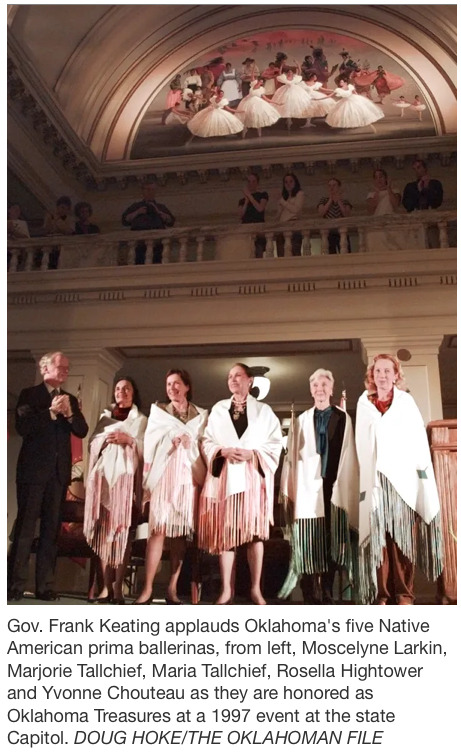
7 notes
·
View notes
Photo

Today we remember the passing of Marlon Brando who Died: July 1, 2004 at Ronald Reagan UCLA Medical Center in Los Angeles, California
Marlon Brando Jr. (April 3, 1924 – July 1, 2004) was an American actor and film director with a career spanning 60 years, during which he won the Academy Award for Best Actor twice. He is regarded as arguably the greatest and most influential actor in 20th-century film. Brando was also an activist for many causes, notably the civil rights movement and various Native American movements. Having studied with Stella Adler in the 1940s, he is credited with being one of the first actors to bring the Stanislavski system of acting and method acting, derived from the Stanislavski system, to mainstream audiences.
He initially gained acclaim and an Academy Award nomination for reprising the role of Stanley Kowalski in the 1951 film adaptation of Tennessee Williams' play A Streetcar Named Desire, a role that he originated successfully on Broadway. He received further praise, and an Academy Award, for his performance as Terry Malloy in On the Waterfront, and his portrayal of the rebellious motorcycle gang leader Johnny Strabler in The Wild One proved to be a lasting image in popular culture. Brando received Academy Award nominations for playing Emiliano Zapata in Viva Zapata! (1952); Mark Antony in Joseph L. Mankiewicz's 1953 film adaptation of Shakespeare's Julius Caesar; and Air Force Major Lloyd Gruver in Sayonara (1957), an adaptation of James Michener's 1954 novel.
The 1960s saw Brando's career take a commercial and critical downturn. He directed and starred in the cult western One-Eyed Jacks, a critical and commercial flop, after which he delivered a series of notable box-office failures, beginning with Mutiny on the Bounty (1962). After ten years of underachieving, he agreed to do a screen test as Vito Corleone in Francis Ford Coppola's The Godfather (1972). He got the part and subsequently won his second Academy Award in a performance critics consider among his greatest. He refused the award due to mistreatment and misportrayal of Native Americans by Hollywood. The Godfather was one of the most commercially successful films of all time, and alongside his Oscar-nominated performance in Last Tango in Paris, Brando reestablished himself in the ranks of top box-office stars.
After a hiatus in the early 1970s, Brando was generally content with being a highly paid character actor in supporting roles, such as Jor-El in Superman (1978), as Colonel Kurtz in Apocalypse Now (1979), and in The Formula (1980), before taking a nine-year break from film. According to the Guinness Book of World Records, Brando was paid a record $3.7 million ($16 million in inflation-adjusted dollars) and 11.75% of the gross profits for 13 days' work on Superman.
Brando was ranked by the American Film Institute as the fourth-greatest movie star among male movie stars whose screen debuts occurred in or before 1950. He was one of only six actors named in 1999 by Time magazine in its list of the 100 Most Important People of the Century. In this list, Time also designated Brando as the "Actor of the Century."
On July 1, 2004, Brando died of respiratory failure from pulmonary fibrosis with congestive heart failure at the UCLA Medical Center. The cause of death was initially withheld, with his lawyer citing privacy concerns. He also suffered from diabetes and liver cancer. Shortly before his death and despite needing an oxygen mask to breathe, he recorded his voice to appear in The Godfather: The Game, once again as Don Vito Corleone. However, Brando recorded only one line due to his health, and an impersonator was hired to finish his lines. His single recorded line was included within the final game as a tribute to the actor. Some additional lines from his character were directly lifted from the film. Karl Malden—Brando's co-star in three films, A Streetcar Named Desire, On the Waterfront, and One-Eyed Jacks—spoke in a documentary accompanying the DVD of A Streetcar Named Desire about a phone call he received from Brando shortly before Brando's death. A distressed Brando told Malden he kept falling over. Malden wanted to come over, but Brando put him off, telling him there was no point. Three weeks later, Brando was dead. Shortly before his death, he had apparently refused permission for tubes carrying oxygen to be inserted into his lungs, which, he was told, was the only way to prolong his life.
Brando was cremated, and his ashes were put in with those of his good friend Wally Cox and another longtime friend, Sam Gilman. They were then scattered partly in Tahiti and partly in Death Valley. In 2007, a 165-minute biopic of Brando for Turner Classic Movies, Brando: The Documentary, produced by Mike Medavoy (the executor of Brando's will), was released.
6 notes
·
View notes
Text
RWRB Study Guide: Chapter 2
Hi y’all! I’m going through Casey McQuiston’s Red, White & Royal Blue and defining/explaining references! Feel free to follow along, or block the tag #rwrbStudyGuide if you’re not interested!
Cakegate (21): Reference to Watergate, a political controversy from the 1970s; the Watergate Scandal still holds quite a bit of prevalence in American culture. (More)
Situation Room (22): the John F. Kennedy Conference Room, AKA “the Situation Room”, is a secure conference room in the basement of the West Wing. (More)
The Sun (22): A British tabloid.
Deputy Chief of Staff (Zahra’s position, 23): The Deputy Chief of Staff is the top aide to the president’s top aide, and is responsible for ensuring that everything runs smoothly within the bureaucracy of the White House.
Howard (24): Howard University is a historically Black university just outside of Washington DC. It opened in 1867, just after the end of the American Civil War and is known for its STEM programs and law school. (More)
Equerry (24): A personal attendant to a member of the royal family (historically, someone who was in charge of their horses).
ITV This Morning (26): A British daytime cable show
SNL (26): Saturday Night Live, an American sketch comedy TV show that brings in a new celebrity host every week.
People (27): An American magazine that covers celebrity gossip.
Clintons (27): Bill Clinton has one child, Chelsea Clinton, and her parents worked to shield her from the press during his presidency.
Sasha and Malia (27): President Obama’s daughters, who were pre-teens and teenagers during his White House years and have faced rather invasive press coverage since.
Patsy Cline (28): An American singer from the 1950s, considered one of the most influential vocalists of the 20th century and one of the firsts artists to cross from country music to pop, (Listen here and here)
Op-Ed (28): “Opposite the Editorial”; a one-page piece of writing for a magazine or other news piece that is not associated with the views of the publication.
Essential Oils, Cabin in the Vermont Wilderness, LLB Vests, Patchouli (29): These are all markers that Nora’s parents are outdoorsy, maybe to the extent of being a bit detached from the “real world”.
Essential Oils: These are oils that can help people relax or create a positive atmosphere, but have little to no health benefits beyond that. Many people believe they can help cure serious or chronic illnesses.
Cabin in the Vermont Wilderness: Vermont’s wooded areas would be a very nice place for a cabin
LLBean vests: LLBean is a brand that sells high-end outdoors clothes
Patchouli: A type of essential oil
Mutton Pie (30): A small, double-crust meat pie native to Scotland but common throughout the UK
Oxford (30): Oxford University is the oldest university in the English-speaking world, and with a 17% acceptance rate in 2017, it is an incredibly difficult school to get into. For American applicants, they require a 3.7 GPA (based on a 4.0 system) and a 32/36 on the ACT. (More)
Eton (31): A posh boarding school for boys 13-18, founded in 1440. It is one of the most prestigious schools in the world.
Great Expectations (31): a 1860-61 novel by Charles Dickens, where a young boy rises above a lowly birth to be “worthy of” a rich girl he falls in love with, (More)
Khakis vs. Chinos (32): Chinos are tighter than khakis and tend to be a bit more dressy. (More)
Gap vs. J. Crew (32): Gap is a relatively inexpensive brand; J. Crew is a more expensive alternative.
SeaWorld San Antonio (32): SeaWorld is a theme park/aquarium known in the past ten years or so for inhumane treatment of its animals.
Walrus Mustache (32): A thick, bushy mustache that falls over the wearer’s mouth. (More)
Land Rover (33): A British brand of car that offers only premium and luxury sport vehicles.
Shaan (33): Hindi name meaning “Pride”.
Aston Martin (33): A sports car favored by James Bond.
Kensington Palace (33): A relatively modest palace surrounded by Kensington Gardens, the traditional home of royal children.
Millionaire who wants to hunt you... (35): A reference to the short story “The Most Dangerous Game”, in which a rich man lures the protagonist to his private island and hunts him for sport.
Texas Panhandle (35): A rural area of northern Texas.
Waterboarded (36): Tortured; this is a reference to America’s history of torturing people in Guantanamo Bay.
Helados (37): Fruit-flavored ice cream bars from Mexico.
Nate Silver (38): American statistician and writer who created an algorithm to predict baseball players’ future success. He has more recently switched to highly accurate political predictions.
GW (38): George Washington University, a college in Washington DC where Alex goes to school.
Data Czar (39): A position in a company where the person who holds it manages that company’s data and reports directly to its top management.
PPOs (39): Private Patrol Officers or bodyguards
Cornettos (39): A British ice cream cone with nuts and chocolate, similar to an American drumstick.
Signet ring (40): A ring with the king’s seal; traditionally that seal would be pressed into wax and would serve as a substitute for the king’s signature. It signifies royal power
Beans and white toast (41): This is... a genuine British breakfast. Just plain beans and white toast. Beans are a staple in both Mexican and Texan/Tex-Mex foods, but they are typically heavily seasoned.
Yellow pill (41): From what I could find, this could be a pill used to deal with anxiety/symptoms of anxiety, such as Clonazepam.
Jolly old England (41): A very English way to refer to England.
Royal Marsden NHS Foundation Trust (44): A specialist cancer treatment hospital in London.
Alliance Starbird (44): The symbol of the Rebel Alliance in the Star Wars movies.
Caipirinhas (50): Brazil’s national cocktail; it is made in large batches and contains a sugar-based hard liquor, sugar, and lime.
Pancreatic cancer (51): A type of cancer that is typically not caught until it has progressed to the point of being incurable. (More)
-------
If there’s anything I missed or that you’d like more on, please let me know! And if you’d like to/are able, please consider buying me a ko-fi? I know not everyone can, and that’s fine, but these things take a lot of time/work and I’d really appreciate it!
Chapter 1 // Chapter 3
#rwrb study guide#rwrb#red white and royal blue#henry fox mountchristen windsor#henry fox mountchristen windsor x alex claremont diaz#alex claremont diaz#bea fox mountchristen windsor#nora holleran#june claremont diaz#pez okonjo#the white house trio#super six#study guide#casey mcquiston#FirstPrince
37 notes
·
View notes
Text
Film Allusions in Crimson Peak
Hi, all! So because I am deep in my horror movie feels at present and, as horror is a genre that some of you are new to/unfamiliar with, want you all to have some more context for Crimson Peak as an intertextual Gothic pastiche, I thought make a little list of films (mostly horror) that CP references, alludes to, or visually echoes (other than Jane Eyre or any iteration of “Bluebeard,” that is). This list is certainly not exhaustive, but I hope will give you a starting place at understanding the scale of the intertextual web this movie is weaving (also maybe give you some movie recs if you’re into horror/classic cinema. I’ll try to include links to films in the public domain).

Nosferatu (1922) and other early 20th century cinema
Del Toro makes use of a lot of the aesthetics and techniques of film from the late Victorian period/early 20th century (appropriate since Crimson Peak is set in the 1890s - incidentally one of the peaks of Gothic literature). One of these is iris shots/iris transitions (shown above in this screenshot from Nosferatu). Iris transitions are when a circular black mask over the shot shrinks, closing the picture to a black screen (very common in early horror film and 1920s cartoons, ie Betty Boop). If you’d like some very iconic, silent vampire cinema, you can watch Nosferatu here at archive.org for free.
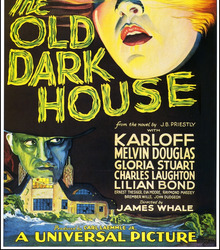
The Old Dark House (1932) | Watch free on Archive.org
Seeking shelter from a storm, five travelers are in for a bizarre and terrifying night when they stumble upon the Femm family estate.
A trope codifier for the haunted house movie, complete with oodles of Gothic weirdness, including those ooky spooky, co-dependent Femm siblings.
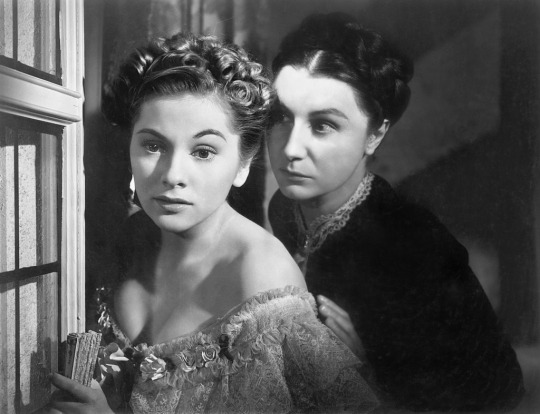
Rebecca (1940) | Watch free on Archive.org
A self-conscious bride is tormented by the memory of her husband's dead first wife.
Based on Daphne Du Maurier’s novel of the same name (itself heavily based on Jane Eyre), this Gothic variation on “Bluebeard” was Alfred Hitchcock’s first American film, won two Academy Awards, and is still considered one of the best psychological thrillers of all time. Features an overbearing female figure who directly interferes with our protagonist’s marriage to her, er, Prince Charming in the form of a Sapphic housekeeper obsessed with keeping the memory of the first Mrs. De Winter alive.

Notorious (1946) | Watch free on Youtube
A woman is asked to spy on a group of Nazi friends in South America. How far will she have to go to ingratiate herself with them?
Don’t drink the tea! Also, butterfly-backed chairs. Allll the butterfly-backed chairs.
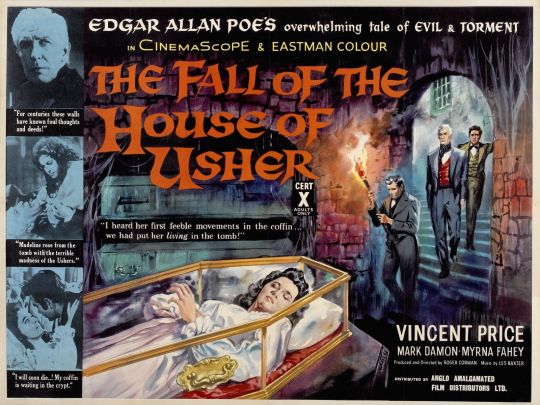
The Fall of the House of Usher (1960)
Upon entering his fiancée's family mansion, a man discovers a savage family curse and fears that his future brother-in-law has entombed his bride-to-be prematurely.
Two prongs here: Crimson Peak is very much playing with Edgar Allan Poe’s short story (incest siblings! Gothic manors sinking into the earth!) and evoking a particular aesthetic associated with a number of 1960s/70s “schlock” Gothic horror films like those made by Roger Corman who applied his use of vivid color and psychedelic surrealism to a number of Poe’s works.
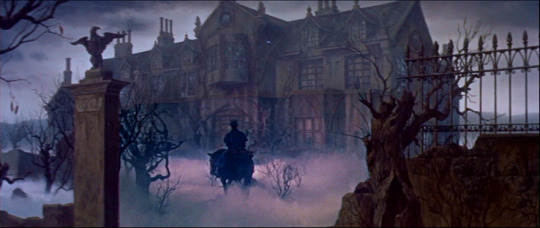
AESTHETIC!!!!! Speaking of aesthetic excess...
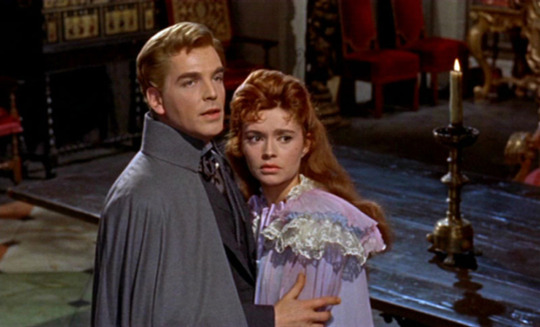
The Brides of Dracula (1960) and other Hammer Horror films
Vampire hunter Van Helsing returns to Transylvania to destroy handsome bloodsucker Baron Meinster, who has designs on beautiful young schoolteacher Marianne.
Known for a series of Gothic horror films made during the 1950s - 1970s featuring well-known characters like Count Dracula, Baron Frankenstein, and The Mummy, Hammer film productions hooked audiences with its use of vivid color, gore, sexy damsels in nightgowns, sexy women with fangs, sexy mummy girls, sexy... you get the idea. It left an indelible aesthetic mark on horror cinema since (including Crimson Peak). Also famous for catapulting the careers of Christopher Lee and Peter Cushing or, as you might know them, Count Dooku and Grand Admiral Tarkin from Star Wars.
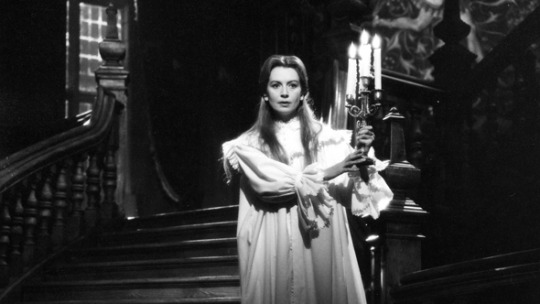
The Innocents (1961)
A young governess for two children becomes convinced that the house and grounds are haunted.
Frequently listed as one of the best horror films of all time, The Innocents (one of Del Toro’s direct inspirations -- clock the nightgown in the screencap) is a loose adaptation of Henry James’ seminal Gothic novella The Turn of the Screw.
So many more under the cut...

The Leopard (1963)
The Prince of Salina, a noble aristocrat of impeccable integrity, tries to preserve his family and class amid the tumultuous social upheavals of 1860's Sicily.
Another of Del Toro’s direct intertexts, which influenced Crimson Peak’s party scenes.
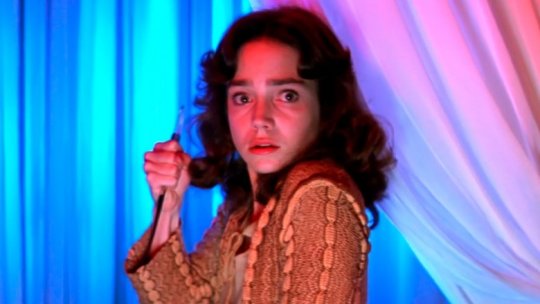
Suspiria (1977), the films of Mario Bava, and giallo cinema
An American newcomer to a prestigious German ballet academy comes to realize that the school is a front for something sinister amid a series of grisly murders.
A cult horror classic, Italian director Dario Argento’s Suspiria plays fast and loose with Gothic horror and fairy tale tropes, making for a slasher film quite unlike any other. Notable for its dreamlike surrealism, use of highly-stylized colorization, and sheer amounts of gore, Suspiria remains one of the most aesthetically influential horror films of all time and, looking at screenshots, you can maybe see its visual influence on films like Crimson Peak:
Guillermo Del Toro has also cited Mario Bava, another of the key figures in the golden age of Italian horror, as inspiration for his use of color and set design in Crimson Peak.
From Bava’s Black Sabbath (1963):

From Blood and Black Lace (1964):
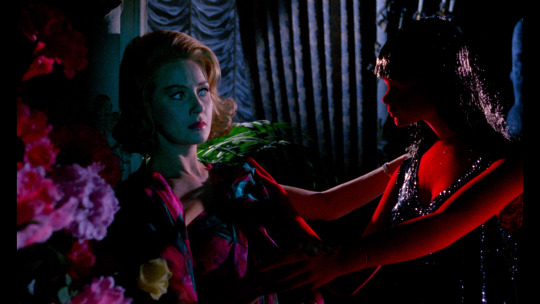
Bava’s film, Blood and Black Lace, belongs to the giallo genre, which refers (at least, in English-speaking countries) to (largely 1970s) Italian horror thrillers/slashers notorious for their combination of intense, stylized violence and eroticism. Very much a precursor to the American slasher film.

The Shining (1980)
A family heads to an isolated hotel for the winter where an evil spiritual presence influences the father into violence, while his psychic son sees horrific forebodings from both past and future.
As film that also loosely adapts “Bluebeard,” it’s perhaps unsurprising that there are so many allusions to Stanley Kubrick’s adaptation of Stephen King’s novel of the same name in Crimson Peak.
And, man, does it have it all! Snowed in, Gothic entrapment! Threats of domestic abuse! Secrets locked away in forbidden rooms! Ghosts! So many ghosts!

Ghosts in the bathtub!
Ludicrously enormous amounts of blood! Innocent waifs with the ability to commune with the dead! Intrepid third parties who heroically make an attempt to reach the isolated Gothic hellscape to help our damsel in distress only to get immediately merc’d! It’s all here, y’all.... except the incest, of course.
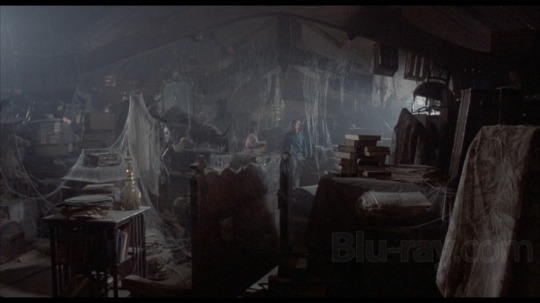
Flowers in the Attic (1987)
Children are hidden away in the attic by their conspiring mother and grandmother.
Ok, this is something of a cheat, as Crimson Peak is alluding more to V.C. Andrews’ infamous novel of the same name, not the 1987 film (which is an abysmally terribly adaptation and hilariously bad flick). Anyway, abused siblings are locked away in an attic... and... well... things get all... Sharpe family values, if you know what I mean.

Bram Stoker’s Dracula (1992)
The centuries old vampire Count Dracula comes to England to seduce his barrister Jonathan Harker's fiancée Mina Murray and inflict havoc in the foreign land.
If you liked Crimson Peak, I think you’ll enjoy this too, as, like CP, this movie is a sincere horror film, but also a pastiche/celebration of the Gothic and vampire cinema. It’s visually sumptuous and very high-energy (if you didn’t like CP or Moulin Rouge!, this one is probably not for you).
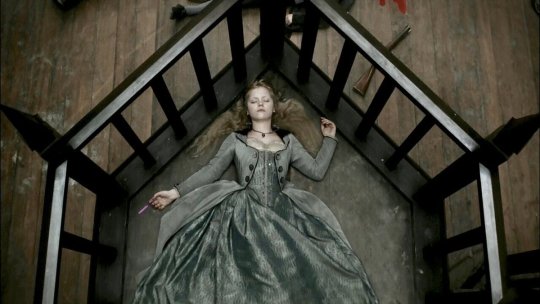
Sleepy Hollow (1999)
Ichabod Crane is sent to Sleepy Hollow to investigate the decapitations of three people, with the culprit being the legendary apparition, The Headless Horseman.
This is another one that, if you liked CP, you might enjoy. Based on Washington Irving’s "The Legend of Sleepy Hollow,” Tim Burton’s film evokes a number of genres and horror aesthetics, most notably the Gothic horror flicks of the 1950s/60s, to create a kind of Hammer Horror film for American Gothic.
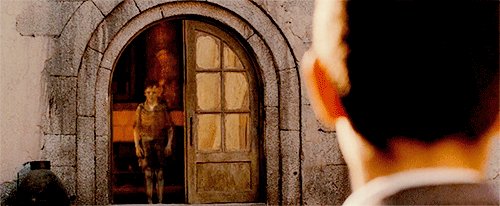
The Devil’s Backbone (2001) and Del Toro’s other films
After Carlos -- a 12-year-old whose father has died in the Spanish Civil War -- arrives at an ominous boys' orphanage, he discovers the school is haunted and has many dark secrets that he must uncover.
Crimson Peak is not Guillermo Del Toro’s first foray into Gothic horror, as ghost stories and dark fairy tales are very much his specialty (as we shall see again in Shape of Water later this semester). I highly recommend his ghosts-as-a-reflection-on-the-trauma-of-war film The Devil’s Backbone and his take on portal fantasy, Pan’s Labyrinth (2006), as they’re both excellent and you can see echoes between them and the effects/visuals of Crimson Peak.
31 notes
·
View notes
Text
Jeanette MacDonald - The Iron Butterfly


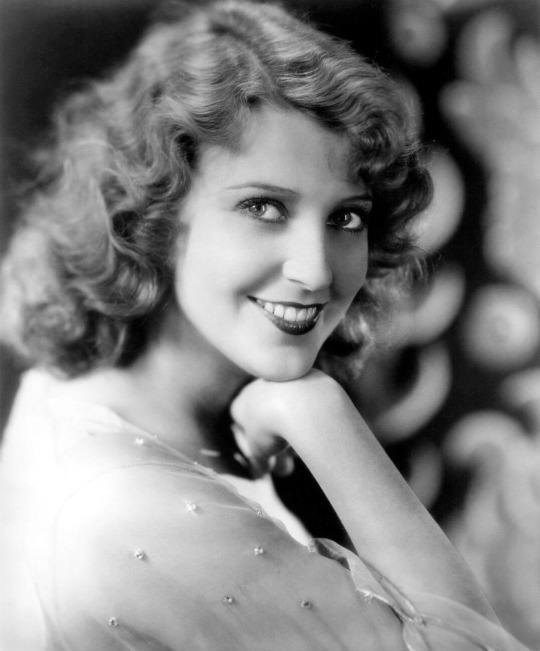






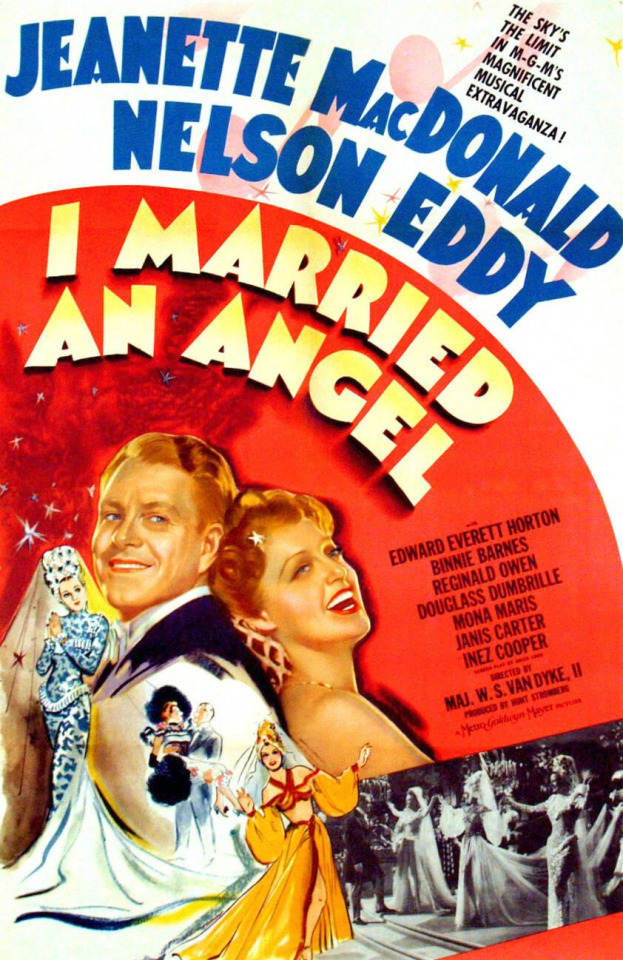
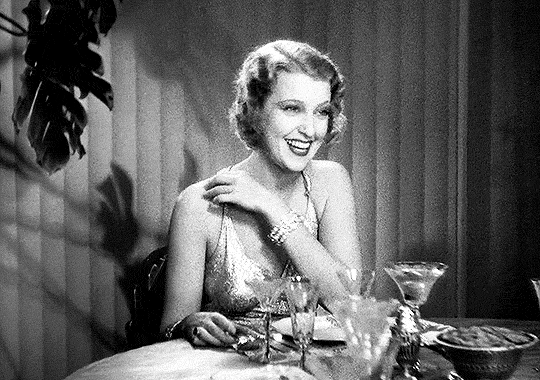

Jeanette Anna MacDonald (born in Philadelphia, Pennsylvania on June 18, 1903) was an American actress best remembered for her musical films in the 1930s. MacDonald was one of the most influential sopranos of the 20th century, introducing opera to film-going audiences and inspiring a generation of singers. She became known as "The Iron Butterfly", for she was one of the most lady-like and beautiful women in Hollywood, but when it came to contracts, she was tough and kept unwanted advances in check, rarely making a misstep in her career.
She was the third daughter of Scottish-American parents and the younger sister to character actress Blossom Rock ( who was most famous as "Grandmama" on the 1960s TV series The Addams Family), whom she followed to New York for a chorus job on Broadway in 1919.
After working her way up from the chorus to starring roles on Broadway, she was casted as the leading lady in Paramount Studios' The Love Parade (1929), a landmark of early sound films. Despite making many successful films with Paramount, she next signed with the Fox.
MacDonald then took a break from Hollywood in 1931 to embark on a European concert tour, performing at the Empire Theater in Paris and at London's Dominion Theatre. She was even invited to dinner parties with British Prime Minister Ramsay MacDonald and French newspaper critics. She returned to Paramount the following year and made more films.
In 1933, MacDonald left again for Europe, and while there signed with MGM, which brought her together with Nelson Eddy. The pair made eight pictures together, including Maytime (1937), arguably the best musical of all time. From then on, they were forever known as America's Singing Sweethearts.
In 1943, she left MGM and began pursuing other interests. She made her opera debut singing Juliette in Gounod's Roméo et Juliette in Montreal at His Majesty's Theatre. After the war, MacDonald made two more films, but quit the movies altogether in 1949. The 1950s found MacDonald in the Las Vegas nightclub circuit, on television, in sold-out concert tours, in studio recordings, and on musical stage productions.
In her final years, MacDonald developed a serious heart condition. She died in Houston, Texas while awaiting heart surgery; she was 61 years old.
Legacy:
Won the Screen Actors Guild award for Maytime (1937)
Crowned as the Queen of the Movies in 1939 by 22 million filmgoers in a New York Daily News survey as presented by Ed Sullivan
Has 2 RCA Red Seal gold records (one for "Indian Love Call" (1936) and another for "Ah, Sweet Mystery of Life" (1935)
Has 1 RIAA gold record for Favorites in Hi-Fi (1959)
Was one of the highest-paid actresses in MGM in the 1930s
Listed by the Motion Picture Herald as one of America’s top-10 box office draws in 1936
Co-founded the Army Emergency Relief and raised funds on concert tours in 1941 to support American troops
Awarded an honorary doctor of music degree from Ithaca College in 1956
Named Philadelphia's Woman of the Year in 1961
Is the namesake of the USC Thornton School of Music built a Jeanette MacDonald Recital Hall built in 1975
Has a bronze plaque unveiled in March 1988 on the Philadelphia Music Alliance's Walk of Fame
Honored with a block in the forecourt of Grauman's Chinese Theatre in 1934
Co-wrote an autobiography, Jeanette MacDonald Autobiography: The Lost Manuscript, in the 1950s and which was eventually published in 2004
Honored as Turner Classic Movies Star of the Month for March 2006
Has two stars on the Hollywood Walk of Fame: 6157 Hollywood Boulevard for motion picture and 1628 Vine Street for recording
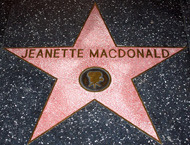
#Jeanette MacDonald#The Iron Butterfly#Silent Films#Silent Movies#Silent Era#Silent Film Stars#Golden Age of Hollywood#Classic Hollywood#Film Classics#Classic Films#Old Hollywood#Vintage Hollywood#Hollywood#Movie Star#Hollywood Walk of Fame#Walk of Fame#Movie Legends#Actress#hollywood actresses#hollywood icons#hollywood legend#movie stars#1900s
3 notes
·
View notes
Photo

New Post has been published on http://lifehacker.guru/10-castles-in-europe-were-ready-to-check-into/
10 Castles in Europe We're Ready to Check Into

Visiting a castle is one thing, but how about staying the night in one? Across Europe, there’s a plethora of castles that open their doors to visitors as overnight accommodation. Feel like royalty in medieval manors surrounded by lush gardens or even a moat. Here are ten castles in Europe we’re ready to check into. Which would you book?
Dromoland Castle, Ireland

Credit: shutterupeire/Shutterstock
A magical pile with a history as long as your arm, Dromoland Castle is grandeur personified. There’s been a castle on this site since the 16th century, though the present structure dates from 1835. It’s now a five-star hotel with a fantastic golf course. In recent years it has attracted a host of celebrity guests including musicians Johnny Cash and Bono, actors John Travolta and Jack Nicholson, former U.S. presidents George W. Bush and Bill Clinton, Nelson Mandela and Richard Branson. While you’re here, you can try clay pigeon shooting, archery, falconry and horse riding. Or just wander the grounds and marvel at the stunning 450-acre estate.
Fortaleza do Guincho, Portugal

Credit: LuisPinaPhotography/Shutterstock
Built in the 17th century as a fortress, Fortaleza do Guincho has been renovated into an exquisite five-star hotel with Michelin-star restaurant thrown in for good measure. But it’s the castle’s isolated location at Cabo da Rocha, Europe’s most westerly point, which provides that extra touch of modern-day drama. Nature has to try that little bit harder, of course, when it rivals such luxury and comfort. Stone staircases, wrought iron chandeliers and sumptuous textiles all add atmosphere to this Portuguese jewel.
Château de Mirambeau, France

Credit: @chateaudemirambeau
French castles come in the form of fancy châteaux, and they don’t come much fancier than this Renaissance gem. The manor’s elegance and serenity belies a checkered history that has seen numerous attacks, devastating fires and a spell of State ownership after the French Revolution. Count Charles Nicolas Duchâtel rebuilt the place in the early 19th century and a major 21st-century renovation saw the castle become one of Sorgente Group’s most sought-after properties.
Schloss Leopoldskron, Austria

Credit: canadastock/Shutterstock
Palatial Schloss Leopoldskron was the work of Prince Leopold Anton Freiherr von Firmian – how’s that for a name? – when he built it as his family home in the 18th century. More famously, in 1918 it was bought by theater impresario Max Reinhardt, who lovingly restored it and came up with the idea of a Salzburg Festival within its walls. Fittingly, it was a filming location for the iconic movie The Sound of Music and features on many of the city’s themed tours. But to venture inside, you need to book a stay at this magnificent castle located at the edge of one of Austria’s most enchanting cities.
Castello dal Pozzo, Italy

Credit: @castello.dalpozzo
Castello dal Pozzo sits on top of a hill overlooking Lake Maggiore and the interiors of this boutique hotel more than match up to the delightful setting. The Visconti family built this romantic castle in the 18th century. The Dal Pozzos have owned it for six generations and go out of their way to ensure that anyone who stays there feels like family. Glittering chandeliers, lavish curtains and cut glass crystal at the table create a luxurious feeling that ensure every guest at this hotel is pampered as befits their location.
Dalhousie Castle, Scotland

Credit: Agent Wolf/Shutterstock
Scotland’s oldest castle started life as the ancestral seat of the Ramsay Clan. Over its 700-year history, Dalhousie Castle has enjoyed Royal patronage – King Edward I and Queen Victoria have both stayed here – as well as a who’s who of the well-to-do and the influential, from Oliver Cromwell to Sir Walter Scott. These days, it could be you who gazes out over its turrets and towers and discovers its passageways, secret hiding places and even its dungeon.
Thorskogs Slott, Sweden

Credit: Nihayet Marof/Shutterstock
Thorskogs Castle lies in a verdant setting, amidst English-style gardens near the Göta Älv River just north of the city of Gothenburg. It opened its doors as a hotel in the mid-1980s with a guest list that reads like a who’s who of world statesmen: George Bush, Mikhail Gorbachev, John Major, Benazir Bhutto and FW de Klerk. There’s been a manor house on this site since the 18th century, but the current building was originally the home of successful shipping magnate Petter Larson and dates from 1892.
Hever Castle, England

Credit: Richard Melichar/Shutterstock
Hever Castle dates back to the 13th century and today remains one of England’s finest castles. It’s everything you dream a castle should be: crenellated, moated and of course, haunted. Anne Boleyn, second wife of King Henry VIII, lived here as a child. A tour of the castle’s fascinating interior will reveal treasures such as fine tapestries, antique furniture, a wonderful collection of Tudor portraits and even Anne’s own prayer books. We can thank William Waldorf Astor for restoring the house and opening the Astor Wing for visitors to stay and become part of English history.
Parador de Cardona, Spain

Credit: joan_bautista/Shutterstock
Around 85km from Barcelona you’ll find the Parador de Cardona. This beautiful hotel occupies a mediaeval 9th-century castle positively dripping with secrets from the past. The castle boasts a resident ghost – if you’re easily spooked, don’t book room 712 where a poltergeist has a penchant for moving the furniture. Décor has been carefully thought through so that heritage features such as the towers and gothic adornments are allowed to shine, but they’re knocked out of the park by the incredible view over the town and surrounding countryside.
Stahleck Castle, Germany

Credit: kamienczanka/Shutterstock
If you’ve read this far and are bemoaning the fact that your paltry travel budget won’t stretch to castle living, Stahleck Castle will be your lifeline. This 12th-century castle, perched on a crag overlooking the breathtaking Lorelei Valley, is actually a hostel. Outside, there’s even a moat, a rare sight when it comes to German castles. Though it looks authentic, the castle is a sympathetic 20th-century reconstruction, but with dorm beds going for less than €25, who’s complaining?
(C)
1 note
·
View note
Photo
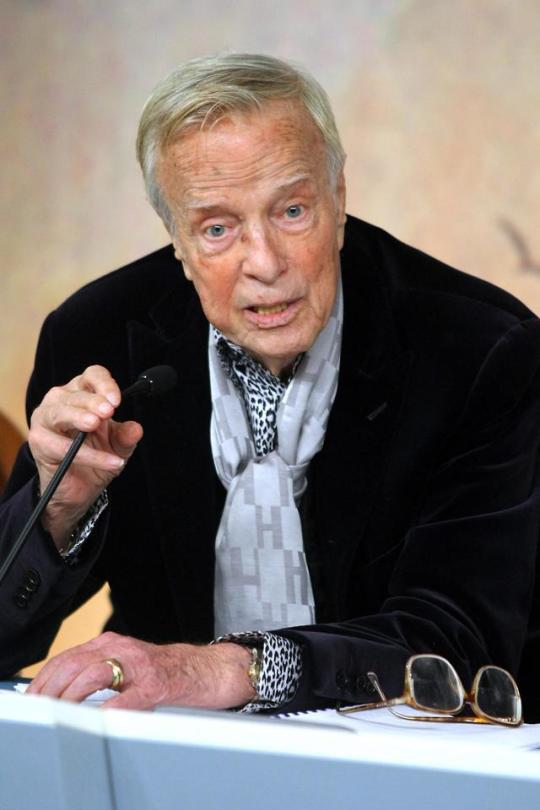
Franco Zeffirelli dies at 96
Franco Zeffirelli, the Italian director and designer who reigned in theater, film and opera as the unrivaled master of grandeur, orchestrating the youthful 1968 movie version of “Romeo and Juliet” and transporting operagoers to Parisian rooftops and the pyramids of Egypt in productions widely regarded as classics, died June 15 at his home in Rome. He was 96.
A son, Luciano, confirmed the death to the Associated Press but did not cite a cause.
Mr. Zeffirelli — a self-proclaimed “flag-bearer of the crusade against boredom, bad taste and stupidity in the theater” — was a defining presence in the arts since the 1950s. In his view, less was not more. “More is fine,” a collaborator recalled Mr. Zeffirelli saying, and as a set designer, he delivered more gilt, more brocade and more grandiosity than many theater patrons expected to find on a single stage.
“A spectacle,” Mr. Zeffirelli once told the New York Times, “is a good investment.”
From his earliest days, he seemed to belong to the opera. Born in Italy to a married woman and her lover, he received neither parent’s surname. His mother dubbed him “Zeffiretti,” an Italian word that means “little breezes” and that arises in Mozart’s opera “Idomeneo,” in the aria “Zeffiretti lusinghieri.” An official mistakenly recorded the name as “Zeffirelli.”
Mr. Zeffirelli grew up mainly in Florence, amid the city’s Renaissance riches, and trained as an artist before being pulled into theater and then film by an early and influential mentor, Luchino Visconti. Mr. Zeffirelli matured into a sought-after director in his own right, staging works in Milan, London and New York City, where he became a mainstay of the Metropolitan Opera.
His first major work as a film director was “The Taming of the Shrew” (1967), a screen adaptation of Shakespeare’s comedy, starring Elizabeth Taylor and Richard Burton. But Mr. Zeffirelli was best known for the Shakespearean adaptation released the next year — “Romeo and Juliet,” starring Leonard Whiting and Olivia Hussey in the title roles.
He reportedly reviewed the work of hundreds of young actors before selecting his two stars, both of whom were still in their teens. With a lush soundtrack by Nino Rota, and with its equally lush visuals, the film won the Academy Award for best cinematography and was a runaway box office success. Film critic Roger Ebert declared it “the most exciting film of Shakespeare ever made.”
It “is the first production of ‘Romeo and Juliet’ I am familiar with in which the romance is taken seriously,” Ebert wrote. “Always before, we have had actors in their 20s or 30s or even older, reciting Shakespeare’s speeches to each other as if it were the words that mattered. They do not, as anyone who has proposed marriage will agree.”
In the opera, an art form already known for its opulence, big voices and bigger personalities, Mr. Zeffirelli permitted himself to be deterred by neither physical nor financial constraints. “Opera audiences demand the spectacular,” he told the Times.
Mr. Zeffirelli had notable artistic relationships with two of the most celebrated sopranos of the 20th century, Maria Callas and Joan Sutherland. But certain Zeffirelli sets seemed to excite the opera world even more than the performers who sang upon them.
One such example was his production of Puccini’s “La Boheme,” an extravaganza set in 19th-century Paris and famous for its exuberant street scene and magical snowfall. After its 1981 premiere at the Met, it was said that the audience lavished on Mr. Zeffirelli a grander ovation than the one reserved for conductor James Levine and the singers who played the opera’s bohemian lovers.
“For the first time,” Mr. Zeffirelli told the Times, “audiences will have a sense of the immensity of Paris, and the smallness of this little group’s place — the actual space of a garret. The acting is now intimate and conversational, which is exactly what Puccini wanted. Since the garret is raised, every whisper and gesture will come across clearly in the theater.”
His production of Verdi’s “Aida,” performed at Milan’s La Scala in 1963 with soprano Leontyne Price and tenor Carlo Bergonzi, featured 600 singers and dancers (including scantily clad belly dancers), 10 horses, towering idols, palm trees and sphinxes littering the expanse of the stage. “I have tried to give the public the best that Cecil B. DeMille could offer,” Mr. Zeffirelli told Time magazine, referring to the Hollywood director’s biblical epics, “but in good taste.”
It was sometimes said that Mr. Zeffirelli was beloved by everyone except music reviewers, some of whom disparaged his style as excessive to the point of taking attention away from the music. Writing in the Times, Bernard Holland panned Mr. Zeffirelli’s set for Puccini’s “Turandot,” set in China, as “acres of white paint and gold leaf topped by the gaudiest of pagodas” and quipped that “if the gods eat dim sum, they certainly do it in a place like this.”
In time, the Metropolitan Opera replaced some of Mr. Zeffirelli’s productions, although the modernistic newcomers — notably Luc Bondy’s dreary “Tosca” in 2009 — did not always prove as popular.
“It’s like somebody decides that the Sistine Chapel is out of fashion,” Mr. Zeffirelli told the Times. “They go there and make something a la Warhol. . . . You don’t like it? O.K., fine, but let’s have it for future generations.”
As for those who had criticized his direction of “Romeo and Juliet” for similar reasons, he retorted, “In all honesty, I don’t believe that millions of young people throughout the world wept over my film ... just because the costumes were splendid.”
Mr. Zeffirelli was born in Florence on Feb. 12, 1923. His father, Ottorino Corsi, was a Florentine businessman, and his mother, Alaide Garosi, was a fashion designer. Her husband was a lawyer, and he died before Mr. Zeffirelli was born.
His mother continued a fraught relationship with Corsi, once attempting to stab him with a hat pin. “The opera? My destiny?” Mr. Zeffirelli observed in a 1986 autobiography, “Zeffirelli.” “I think there is a case to be made.”
After the death of his mother when he was 6, he became the charge of an aunt. He recalled his upbringing in the 1930s in the semi-autobiographical film “Tea With Mussolini” (1999), which he directed and which starred Maggie Smith, Judi Dench and Joan Plowright as English expatriates in Florence who take in a parentless child during the era of fascist rule.
Mr. Zeffirelli attended art school before studying architecture at the University of Florence. His studies were put on hold during World War II, when he fought alongside antifascist partisans. His interests shifted more toward film, particularly after he saw Laurence Olivier star in the 1944 Technicolor film adaptation of Shakespeare’s “Henry V,” which Olivier also directed.
“The lights went down and that glorious film began,” Mr. Zeffirelli recalled in his memoir. “I knew then what I was going to do. Architecture was not for me; it had to be the stage.”
He met Visconti while working in Florence as a stagehand. Visconti, with whom he lived for a period, gave him his push into professional work, hiring him to work as a designer for an Italian stage production of Tennessee Williams’s “A Streetcar Named Desire” in 1949.
Mr. Zeffirelli soon began designing and directing at La Scala and later the Met. He designed, directed and adapted from Shakespeare the libretto for the production of Samuel Barber’s “Antony and Cleopatra” that opened the Met’s new opera house at Lincoln Center in 1966.
Mr. Zeffirelli said he found it invigorating to shift from one art form to another. His theatrical productions starred top-flight actors including Albert Finney and Anna Magnani. On television, he directed “Jesus of Nazareth,” an acclaimed 1977 miniseries with a reported price tag of $18 million and a cast that included Robert Powell as Jesus, Hussey as the Virgin Mary, Olivier as Nicodemus, Anne Bancroft as Mary Magdalene and James Earl Jones as Balthazar.
Mr. Zeffirelli received a best director Oscar nomination for “Romeo and Juliet.” (He lost to Carol Reed for the musical “Oliver!”) He also garnered a nomination for best art direction for his 1982 film adaptation of Verdi’s opera “La Traviata,” starring Teresa Stratas and Plácido Domingo, one of several such operatic film adaptations he made.
His other notable films included “Hamlet” (1990) starring Mel Gibson and Glenn Close. Less acclaimed was “Endless Love” (1981), starring Brooke Shields and Martin Hewitt in a tragic story of teen romance, which Mr. Zeffirelli admitted was “wretched.”
Politically, Mr. Zeffirelli positioned himself on the right, serving as a senator in the political party Forza Italia. “I have found it an irritating irony that those who espouse populist political views often want art to be ‘difficult,’ ” he wrote in his memoir. “Yet I, who favor the Right in our democracy, believe passionately in a broad culture made accessible to as many as possible.”
He described himself as homosexual, preferring not to use the word “gay.” In 2000, he adopted two adult sons, Pippo and Luciano, both former lovers, according to the newspaper the Australian. A complete list of survivors was not immediately available.
Looking back on his life and career, Mr. Zeffirelli once told The Washington Post that he was struck by “how much is risked to become something” — “to make something of his life,” he continued, speaking of himself in the third person. To show that “he’s not a bastard.”
Daily inspiration. Discover more photos at http://justforbooks.tumblr.com
16 notes
·
View notes
Text
News and important updates on POS System Equipment & POS.
Scenes from The Searchers (1956), starring John Wayne and set during the Texas-Indian Wars. The film is considered one of the most influential Westerns ever made.
“It just so happens we be Texicans,” says Mrs. Jorgensen, an older woman wearing her blond hair in a tight bun, to rough-and-tumble cowboy Ethan Edwards in the 1956 film The Searchers. Mrs. Jorgensen, played by Olive Carey, and Edwards, played by John Wayne, sit on a porch facing the settling dusk sky, alone in a landscape that is empty as far as the eye can see: a sweeping desert vista painted with bright orange Technicolor. Set in 1868, the film lays out a particular telling of Texas history, one in which the land isn’t a fine or good place yet. But, with the help of white settlers willing to sacrifice everything, it’s a place where civilization will take root. Nearly 90 years after the events depicted in the film, audiences would come to theaters and celebrate those sacrifices.
“A Texican is nothing but a human man way out on a limb, this year and next. Maybe for 100 more. But I don’t think it’ll be forever,” Mrs. Jorgensen goes on. “Someday this country’s going to be a fine, good place to be. Maybe it needs our bones in the ground before that time can come.”
There’s a subtext in these lines that destabilizes the Western’s moral center, a politeness deployed by Jorgensen that keeps her from naming what the main characters in the film see as their real enemies: Indians.
In the film, the Comanche chief, Scar, has killed the Jorgensens’ son and Edwards’ family, and abducted his niece. Edwards and the rest of Company A of the Texas Rangers must find her. Their quest takes them across the most treacherous stretches of desert, a visually rich landscape that’s both glorious in its beauty and perilous given the presence of Comanche and other Indigenous people. In the world of the Western, brutality is banal, the dramatic landscape a backdrop for danger where innocent pioneers forge a civilization in the heart of darkness.
The themes of the Western are embodied by figures like Edwards: As a Texas Ranger, he represents the heroism of no-holds-barred policing that justifies conquest and colonization. While the real Texas Rangers’ history of extreme violence against communities of color is well-documented, in the film version, these frontier figures, like the Texas Rangers in The Searchers or in the long-running television show The Lone Ranger, have always been portrayed as sympathetic characters. Edwards is a cowboy with both a libertarian, “frontier justice” vigilante ethic and a badge that puts the law on his side, and stories in the Western are understood to be about the arc of justice: where the handsome, idealized male protagonist sets things right in a lawless, uncivilized land.
The Western has long been built on myths that both obscure and promote a history of racism, imperialism, toxic masculinity, and violent colonialism. For Westerns set in Texas, histories of slavery and dispossession are even more deeply buried. Yet the genre endures. Through period dramas and contemporary neo-Westerns, Hollywood continues to churn out films about the West. Even with contemporary pressures, the Western refuses to transform from a medium tied to profoundly conservative, nation-building narratives to one that’s truly capable of centering those long victimized and villainized: Indigenous, Latinx, Black, and women characters. Rooted in a country of contested visions, and a deep-seated tradition of denial, no film genre remains as quintessentially American, and Texan, as the Western, and none is quite so difficult to change.
*
With origins in the dime and pulp novels of the late 19th century, the Western first took to the big screen in the silent film era. The Great Train Robbery, a 1903 short, was perhaps the genre’s first celluloid hit, but 1939’s Stagecoach, starring Wayne, ushered in a new era of critical attention, as well as huge commercial success. Chronicling the perilous journey of a group of strangers riding together through dangerous Apache territory in a horse-drawn carriage, Stagecoach is widely considered to be one of the greatest and most influential Westerns of all time. It propelled Wayne to stardom.
During the genre’s golden age of the 1950s, more Westerns were produced than films of any other genre. Later in the 1960s, the heroic cowboy character—like Edwards in The Searchers—grew more complex and morally ambiguous. Known as “revisionist Westerns,” the films of this era looked back at cinematic and character traditions with a more critical eye. For example, director Sam Peckinpah, known for The Wild Bunch (1969), interrogated corruption and violence in society, while subgenres like spaghetti Westerns, named because most were directed by Italians, eschewed classic conventions by playing up the dramatics through extra gunfighting and new musical styles and creating narratives outside of the historical context. Think Clint Eastwood’s The Good, the Bad, and the Ugly (1966).
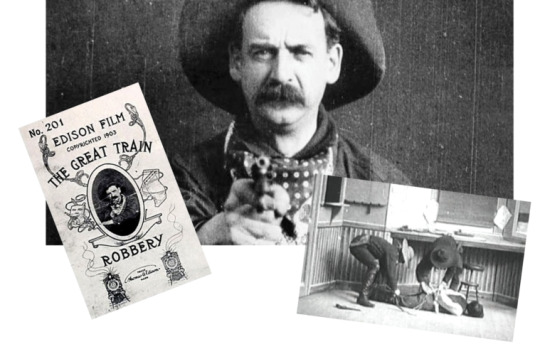
The Great Train Robbery (1903), a short silent film, was perhaps the first iconic Western.
In the wake of the anti-war movement and the return of the last U.S. combat forces from Vietnam in 1973, Westerns began to decline, replaced by sci-fi action films like Star Wars (1977). But in the 1990s, they saw a bit of rebirth, with Kevin Costner’s revisionist Western epic Dances With Wolves (1990) and Eastwood’s Unforgiven (1992) winning Best Picture at the Academy Awards. And today, directors like the Coen brothers (No Country for Old Men, True Grit) and Taylor Sheridan (Hell or High Water, Wind River, Sicario) are keeping the genre alive with neo-Westerns set in modern times.
Still, the Old West looms large, says cultural critic and historian Richard Slotkin. Today’s Western filmmakers know they are part of a tradition and take the task seriously, even the irreverent ones like Quentin Tarantino. Tarantino called Django Unchained (2012) a spaghetti Western and, at the same time, “a Southern.” Tarantino knows that the genre, like much of American film, is about violence, and specifically racialized violence: The film, set in Texas, Tennessee, and Mississippi, flips the script by putting the gun in the hand of a freed slave.
Slotkin has written a series of books that examine the myth of the frontier and says that stories set there are drawn from history, which gives them the authority of being history. “A myth is an imaginative way of playing with a problem and trying to figure out where you draw lines, and when it’s right to draw lines,” he says. But the way history is made into mythology is all about who’s telling the story.
Slotkin’s work purports that the logic of westward expansion is, when boiled down to its basic components, “regeneration through violence.” Put simply: Kill or die. The very premise of the settling of the West is genocide. Settler colonialism functions this way; the elimination of Native people is its foundation. It’s impossible to talk about the history of the American West and of Texas without talking about violent displacement and expropriation.
“The Western dug its own hole,” says Adam Piron, a film programmer at the Sundance Indigenous Institute and a member of the Kiowa and Mohawk tribes. In his view, the perspectives of Indigenous people will always be difficult to express through a form tied to the myth of the frontier. Indigenous filmmakers working in Hollywood who seek to dismantle these representations, Piron says, often end up “cleaning somebody else’s mess … And you spend a lot of time explaining yourself, justifying why you’re telling this story.”
While the Western presents a highly manufactured, racist, and imperialist version of U.S. history, in Texas, the myth of exceptionalism is particularly glorified, perpetuating the belief that Texas cowboys, settlers, and lawmen are more independent, macho, and free than anywhere else. Texas was an especially large slave state, yet African Americans almost never appear in Texas-based Westerns, a further denial of histories. In The Searchers, Edwards’ commitment to the white supremacist values of the South is even stronger than it is to the state of Texas, but we aren’t meant to linger on it. When asked to make an oath to the Texas Rangers, he replies: “I figure a man’s only good for one oath at a time. I took mine to the Confederate States of America.” The Civil War scarcely comes up again.
The Texas Ranger is a key figure in the universe of the Western, even if Ranger characters have fraught relationships to their jobs, and the Ranger’s proliferation as an icon serves the dominant Texas myth. More than 300 movies and television series have featured a Texas Ranger. Before Chuck Norris’ role in the TV series Walker, Texas Ranger (1993-2001), the most famous on-screen Ranger was the titular character of The Lone Ranger (1949-1957). Tonto, his Potawatomi sidekick, helps the Lone Ranger fight crime in early settled Texas.
Meanwhile, the Ranger’s job throughout Texas history has included acting as a slave catcher and executioner of Native Americans. The group’s reign of terror lasted well into the 20th century in Mexican American communities, with Rangers committing a number of lynchings and helping to dispossess Mexican landowners. Yet period dramas like The Highwaymen (2019), about the Texas Rangers who stopped Bonnie and Clyde, and this year’s ill-advised reboot of Walker, Texas Ranger on the CW continue to valorize the renowned law enforcement agency. There is no neo-Western that casts the Texas Ranger in a role that more closely resembles the organization’s true history: as a villain.

The Coen brothers’ No Country for Old Men (2007) ushered in the era of neo-Westerns set in modern times.
Ushered in by No Country for Old Men (2007), also set in Texas, the era of neo-Westerns has delivered films that take place in a modern, overdeveloped, contested West. Screenwriter Taylor Sheridan’s projects attempt to address racialized issues around land and violence, but they sometimes fall into the same traps as older, revisionist Westerns—the non-white characters he seeks to uplift remain on the films’ peripheries. In Wind River (2017), the case of a young Indigenous woman who is raped and murdered is solved valiantly by action star Jeremy Renner and a young, white FBI agent played by Elizabeth Olsen. Sheridan’s attempt to call attention to the epidemic of missing and murdered Indigenous women still renders Indigenous women almost entirely invisible behind the images of white saviors.
There are directors who are challenging the white male gaze of the West, such as Chloé Zhao, whose recent film Nomadland dominated the 2021 Academy Award nominations. In 2017, Zhao’s film The Rider centered on a Lakota cowboy, a work nested in a larger cultural movement in the late 2010s that highlighted the untold histories of Native cowboys, Black cowboys, and vaqueros, historically Mexican cowboys whose ranching practices are the foundation of the U.S. cowboy tradition. And Concrete Cowboy, directed by Ricky Staub and released on Netflix in April, depicts a Black urban horse riding club in Philadelphia. In taking back the mythology of the cowboy, a Texas centerpiece and symbol, perhaps a new subgenre of the Western is forming.
Despite new iterations, the Western has not been transformed. Still a profoundly patriotic genre, the Western is most often remembered for its classics, which helped fortify the historical narrative that regeneration through violence was necessary for the forging of a nation. In Texas, the claim made by Mrs. Jorgensen in The Searchers remains a deeply internalized one: The history of Texas is that of a land infused with danger, a land that required brave defenders, and a land whose future demanded death to prosper.
In Westerns set in the present day, it feels as if the Wild West has been settled but not tamed. Americans still haven’t learned how to live peacefully on the land, respect Indigenous people, or altogether break out of destructive patterns of domination. The genre isn’t where most people look for depictions of liberation and inclusion in Texas. Still, like Texas, the Western is a contested terrain with an unclear future. John Wayne’s old-fashioned values are just one way to be; the Western is just one way of telling our story.
This article was first provided on this site.
We hope you found the article above of help and/or of interest. Similar content can be found on our main site: southtxpointofsale.com
Please let me have your feedback below in the comments section.
Let us know what topics we should write about for you in the future.
youtube
#Point of Sale#harbortouch Lighthouse#harbortouch Pos#lightspeed Restaurant#point of sale#shopkeep Reviews#shopkeep Support#toast Point Of Sale#toast Pos Pricing#toast Pos Support#touchbistro Pos
0 notes
Text
The Internal Debate Within the Writer of One Night in Miami and Soul
https://ift.tt/38MGi5k
It’s one of the most kinetic moments in One Night in Miami. As a character observes, the banter is over and friends are pulling out knives: Kingsley Ben-Adir’s Malcolm X just challenged Leslie Odom Jr.’s Sam Cooke on his responsibility as a Black artist to the Black community.
“You bourgeois negroes are too happy with your scraps to know what’s at stake here,” Malcolm says, demanding Sam take advantage of this elusive thing called celebrity and speak up for all those voices who never got a mic. Yet to Cooke—an artist with his own record label that keeps the rights of Black music in Black hands—this is the height of hypocrisy.
“Everybody talks about how they want a piece of the pie,” Sam counters. “Well, I don’t. I want the goddamn recipe.”
Even for a younger audience who may not be familiar with Cooke’s music, or Malcolm X’s autobiography, the debate of social responsibility in American life rings as urgently in 2021 as it does in the film’s 1964 setting—and it echoes acutely too for Kemp Powers, the writer who penned One Night in Miami twice: first as a play and now a film. He can hear it in his debates with other Black artists over the years, and between the lines of books he’s read about each of the men in his story—he can even hear the debate waging in his own head, whether it’s while authoring a passion project like Miami or co-writing and co-directing Soul, the first Pixar film to star a Black man.
“It’s a debate that’s been happening since long before that night between Malcolm and Sam,” Powers says over a Zoom call. “It’s a debate that still happens now, and is a question that I think Black creatives ask ourselves all the time. What, if any, social responsibility do we have as a Black athlete, artist, or public figure? There’s no real clear answer to it, but that being said, almost everyone has an opinion.”
Powers has entertained several over the years, sometimes at the same time. In his youth he may have more clearly favored Sam’s pragmatic sensibility of working within the system, but at age 47 he has long realized, “I can see myself as just a writer or director, or whatever, but society is going to call me a Black writer-director whether I want it or not.” Thus the question becomes how to manage that reality, whether as a playwright or one of the four most influential Black artists, athletes, and leaders of the mid-20th century.
“So many people have asked me about, who do I think is right, Malcolm or Sam?” Powers reveals, remarkably without sighing. “That misses the point, because ultimately the argument they’re having is just the inner monologue that goes on inside my head all the time… and the answer is it’s situational. Some days you got to be like Sam about it, and other days you got to be like Malcolm about it.”
And sometimes you have to be both on the same day.
Indeed, Powers first put One Night in Miami out into the world as a play in 2013. Back then he had no aspirations of becoming a filmmaker. And yet, by the time a film adaptation gained momentum, he’d already begun working with Pixar in Emeryville, California on retooling Soul as the story of a jazz musician in a real existential crisis. The two films, technically speaking, were released on the same Christmas Day, and One Night in Miami is now having its streaming premiere on Amazon Prime Video a few weeks later.
The serendipity of the complementary releases amuses Powers, as does the strange coincidence that Miami would take such a winding path to the screen that it’d catch up with him as a filmmaker. Still, even between these two movies, Powers sees that same internal debate now playing across multiple streaming services.
“My Sam and my Malcolm are on full display with Soul and One Night in Miami as a writer,” Powers chuckles. “You’re seeing me work within an existing system to try to bring about some positive change that might not be fast enough for some people, but it’s a quantum change; it’s a massive, massive change at this huge company that hasn’t had a lot of representation for us, and at the same time you’re seeing me unfiltered in an independent film where I literally can write whatever I want, and it just goes out there unfiltered. So you’re seeing how both can be positive and effective, right?”
It can also mean historical figures jokingly referenced in Soul like Muhammad Ali—who appears as one of 22’s mentors in that film—can also take a spotlight role via One Night in Miami. In fact, Ali is the crux of a curious historical detail Powers turned into a fascinating fiction. On the night Cassius Clay (an uncanny Eli Goree in the film) took the heavyweight championship of the world from Sonny Liston by TKO, the 22-year-old champ chose to celebrate the victory by quietly hanging out in a motel with his mentor Malcolm X, and pals Sam Cooke and Jim Brown (Aldis Hodge). The next day, Clay officially changed his name to Cassius X and announced his joining of the Nation of Islam.
All of that actually happened. But what did they say to each other that night before Cassius took the first step to becoming Ali? And did it cause Cooke to write “A Change is Gonna Come?” Very few details are truthfully known—Powers even reveals one of the few concrete facts is that they were served pints of vanilla ice cream that night (alcohol is forbidden by the Nation of Islam). But then Powers was one of the first to extensively consider the ramifications of all four men in one place at one significant time.
“Usually when you see that night mentioned, it’s mentioned in the context of a story that’s focusing on only one of them,” Powers says. That’s how he came to learn about it, as a minor detail in Mike Marqusee’s Redemption Song: Muhammad Ali and the Spirit of the Sixties, which Powers first picked up about 15 years ago.
“Obviously the focus was very much on Muhammad Ali throughout the entire book,” Powers says. “So it’s a coincidental fact to the writer of the book, who’s focusing on Muhammad Ali, who was not going to see it through the way I was seeing it. [Between] all of them, what is the power dynamic? What’s the friendship like between four guys who were not just influential, but [were] also in different disciplines?”
Powers likens it to the Rat Pack, which was primarily composed of Frank Sinatra, Dean Martin, and Sammy Davis Jr., among others. To this day, popular culture idolizes and deifies them as best bros playing cards and crooning ballads in Las Vegas. “And they’re all singers!” Powers contends. “But I think this is like that on an exponentially different level, because they’re not all the same thing. You have an entertainer, you have an athlete, you have a political activist.”
Ultimately, Powers jokes they’re a bit like the Black Avengers, with each having been romanticized to the point of becoming superhuman in pop culture over the decades. It’s certainly how Powers came to them, with the scribe having a special affinity with Malcolm X after reading his autobiography as a teenager. “It’s a formative experience shared, I think, with a lot of Black men of my generation.”
Sam Cooke, who he came to later, was his grandmother’s favorite artist; Jim Brown represented Black strength to a whole generation, and took on a mythic aura by the time Powers came of age; and Ali was just on a whole other plain of existence. “Ali was a hero of mine growing up and I didn’t even know why,” Powers muses.
Yet upon learning all four shared the same space, he found an excuse, and an opportunity, to imagine what these men said behind closed doors and among ostensible equals. In the process, Powers could use literary license to also dive deeper into each of these four men’s towering iconographies, and what lay beneath.
Read more
Movies
The Best Movies of 2020
By David Crow and 5 others
Movies
Soul Ending Explained: What Happens Next to Joe?
By David Crow and 1 other
“I wanted to definitely show the private version of all four men. The whole point of them being in this private space away is that we’ve seen so much of them in the public eye.” But in One Night in Miami, each looks strangely more comfortable sitting with their own thoughts, whether that means by strumming a guitar or holding a camera—thereby removing himself from the other three—than on stage or in the arena.
“We have a movie with Jim Brown with no football in it,” says Powers. “We have a movie with Muhammad Ali that has tiny fragments of two boxing matches, but not even one complete boxing match; we have a movie with Sam Cooke where, relatively speaking, he doesn’t sing that much; and we have a movie with Malcolm X in which he doesn’t give a speech.”
The writer credits director Regina King with making those fleeting moments that aren’t in his original play crackle with energy—the half a round we see of Clay dominating Liston or the glimpses of Cooke winning over a crowd, while also feuding with Jackie Wilson, no less. But unlike so many conventional (and often meandering) biopics, there is an emphasis here on specificity of narrative, and specificity of these men’s characters.
Says Powers, “With a snapshot, you have the freedom of focusing on who that person was at that moment of time. You don’t have to bring them into this modern context and be like, ‘Well, how is this person perceived now?’” He adds, “I feel like with two hours or less, I want to focus on that humanity.”
With One Night in Miami, and even Soul, Powers finds theirs, as well as reveals his own.
One Night in Miami is streaming on Amazon Prime video now.
cnx.cmd.push(function() { cnx({ playerId: "106e33c0-3911-473c-b599-b1426db57530", }).render("0270c398a82f44f49c23c16122516796"); });
The post The Internal Debate Within the Writer of One Night in Miami and Soul appeared first on Den of Geek.
from Den of Geek https://ift.tt/2LskEL7
0 notes
Text
An Introduction to Orson Welles - The (Belated) 2018 Director’s Marathon

Authors Note: The following novella-length essay on the history of Orson Welles was written to be the December 2018 Directors Marathon as is a tradition for this blog. It was submitted to Geeks Under Grace wherein it was rejected for its excessive length. After several months of consideration as to how to rework the piece into something publishable within the website’s requirements, it is being published now as was initially intended at the AntiSocialCritic Blog.
"I started at the top and I've been working my way down ever since."
- Orson Welles F for Fake
In the early morning of October 10, 1985, Orson Welles suffered a heart attack and died at his desk. He departed the world he had left such a massive impact upon as quietly and mundanely as a great man could. Just hours before the once superstar artist made his final public appearance on The Merv Griffon Show where he talked about his life. Prior to that in the weeks before he had starred in his final cinematic role while providing the voice of Unicron for Transformers: The Movie. His funeral was a quiet affair at a local hotel, surrounded by his surviving close friends and estranged family members from multiple marriages. You might view this humble affair and fail to understand that the man being eulogized was, in fact, one of the greatest artists of the 20th century. Across his massive career, Orson Welles became a pioneer of theater, radio, and film that pushed forward and challenged those art forms radically. He was intelligent, charismatic, well-read and alluring with an ability to command an audience through his words and presence. He was a showman, an actor as well as a magician but also a creative mind with a unique understanding and love for art.
Yet for all of his creativity across a half-century of output he's almost entirely remembered solely for two major events early in his career. In 1938, he performed a radio rendition of H.G. Welles' War of the Worlds that supposedly ginned up a massive panic on the East Coast of the United States. Then in 1941, he directed Citizen Kane for RKO Radio Productions which would eventually go on to become the most acclaimed film in the history of cinema. As a result, his public image rapidly declined. He became recognized as a washed up, unreliable filmmaker with obesity problems and a bombastic personality. This version of Welles would become the stereotype so brutally mocked by comedians on television shows like The Simpsons, The Critic and Pinky and the Brain. Despite being pigeon-holed and written off within a decade of the peak of his career he continued to work as a filmmaker and an actor across North America and Europe for decades until his death. As excellent as his inaugural effort was his career has dozens of excellent films and performances that are well worth revisiting. Thankfully there has never been a better time to go back and review the works of Orson Welles than right now.
On November 2nd, 2018, Netflix published what will likely be the last of his posthumous works with The Other Side of the Wind. I reviewed the film for Geeks Under Grace at the time it released and have spent the last month reflecting on the experience of seeing such a culturally significant film. It's not every day that a lost piece of art is drudged up and rebuilt from the ground up. Beyond that, the film carries with it so many beautiful reflections, moments of brilliant and visual poetry. Knowing that it's the inheritor of such a vital legacy adds a great deal of weight to the film.
When I started writing publicly one of the first major article series I worked on was a project I called the Director Marathons. From 2014-2017 I did a yearly dive every December into the full filmography of a famous acclaimed director. Over the first four marathons, I dug through the collective works of Quentin Tarantino, Christopher Nolan, Guillermo Del Toro, and The Coen Brothers. I also did an additional six-month breakdown on the entire filmography of Steven Spielberg. Now that Geeks Under Grace is my home for writing I want to continue that tradition here. I considered several major filmmakers including Sam Raimi, John Carpenter, George Romero, and Martin Scorsese but with the release of The Other Side of the Wind, it became clear to me that no director more deserve the attention afforded by a total viewing of their body of work than Orson Welles.
What follows are a series of brief historical retrospectives and film analysis's meant to offer a brief look into the seventy-year life of the man of the hour. For every analysis I offer there is a greater and deeper discussion that every subject of his life I bring up can be made. In the name of brevity, I want this series to be largely introductory (12.5 thousand words of introduction...). The secret of great art is that there are always depths to be plumed within it, nuances to observe and details to be discussed. With Welles part of the appeal beyond his incredible eye for detail is his desire to push the boundaries of the art forms he tackled. Every project and chapter of his life could fill a thick book with all the details that go into them. Film improved as an art form because of his embrace of expressionism and innovative use of technology. Filmmakers as vital as Steven Spielberg and Martin Scorsese regularly host his works among the most influential and beloved of the movies that inspired theirs. There is so much immense history and artistry that can be delved into across the full career of Orson Welles.
That being said, as we learn in his inaugural film Citizen Kane, this can be something of a fruitless endeavor. You can never fully know the full life of a man based on what he leaves behind. Much like Charles Foster Kane's home Xanadu, his works stand as an eternal memorial to Welles' incredible creativity. Lost in the ruins of his career is the man that can only be remembered. These works aren't him. They're all we have left of him. There will never be a Rosebud moment where we understand the inner life of Orson Welles. Even so, the life of Welles is a grand one of ups and downs. In spite of the challenges, we shall do our best to look through the art to see the man.
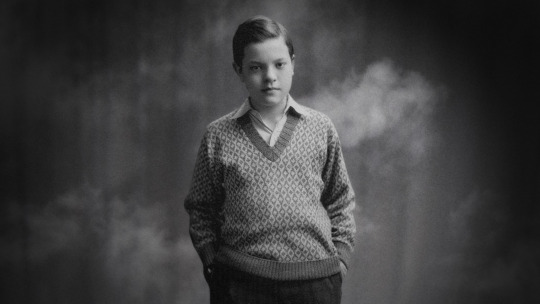
1. The Young Orson Welles
Orson Welles's early life was faced with much splendor and difficulty. Born to Richard and Beatrice Welles in Kenosha, Wisconsin on May 6, 1915, his family was at one point very affluent and wealthy as his father invented a bicycle lamp that allowed the family to move to Chicago. He eventually stopped working and subsumed to alcoholism. Richard and Beatrice would separate in 1919. Orson's mother found work at the Art Institute of Chicago as a pianist performing for lectures. On May 10, 1924, Beatrice would die of Hepatitis, leaving the nine-year-old Welles without a proper family.
Welles lived with his alcoholic father for three years, traveling the world and attending multiple schools. He would eventually settle himself at the Todd Seminary School for Boys in Woodstock, IL where he would set his roots. Later in this life, Welles revealed that Woodstock was the closest thing he had to a home. "Where is home?" Welles replied, "I suppose it's Woodstock, Illinois if it's anywhere. I went to school there for four years. If I try to think of a home, it's that."
The Todd School for Boys ended up being the catalyst for much of Welles intellectual development. His teachers fostered his fascination with acting and the arts and gave the incredibly intelligent young man free rein to expand himself. At age 15, Orson's father passed away from heart and kidney failure. Following High School, the young man found himself awash with opportunities including a scholarship to Harvard University which he declined. After a brief multi-week flirtation with the Art Institute of Chicago, the adventurous young Welles sought a life of travel.

2. Man of the Stage
Welles gallivanted across Europe using the remains of his inheritance. During a stay in Dublin, Ireland the young man approached the manager of the Gate Theater claiming he was a famous Broadway actor that ought to have a position on the stage. The manager didn't believe him yet gave him the job anyway based on his charisma and bravery. His stage debut was on October 13, 1931, in the role of Duke Karl Alexander of Wurttemberg in the play Jew Suss. He would act in several more Dublin productions including an adaptation of W. Somerset Maugham's The Circle at the Abbey Theater. He would try and seek further work in London but failed to acquire a work permit and thus returned to the United States.
Upon his return, Welles made his American debut as a man of the stage at the Woodstock Operahouse in Woodstock, IL. Welles immediately sought out his Irish compatriots from the Gate Theater to stage a drama festival in Woodstock consisting of Trilby, Hamlet, The Drunkard, and Tsar Paul. During this time he also got his first radio gig working on The American School of the Air and shot his first short film.
After marrying Chicago socialite Virginia Nicholas in 1934, Welles moved to New York City where he performed the role of Tybalt in an adaptation of Romeo and Juliet. On March 22, 1935, Orson made his radio premiere on the CBS Radio series The March of Time doing a scene from the 1935 Archibald MacLeish play Panic. Radio would become his primary income as the money he immediately started making with CBS was significant. Welles had moved to New York at the height of the Great Depression and ended up being in exactly the right place to benefit. The Federal Theater Project had been crafted by the Works Progress Administration as a method of helping to bring economic relief to struggling artists. Welles jumped on the opportunity and began funneling money from his incredibly lucrative $1,500/week Radio work into the theater project. President Roosevelt would quip that Orson Welles was the only person in history to illegally siphon money into a government project. The arrangement suited most everyone however and was looked the other way on. Famously Welles became so busy during this time in his life that he hired an ambulance to transport him back and forth across New York City at full speed between his radio performances and his theater directing jobs.
His first work became the incredibly famous and then wildly transgressive production of Voodoo Macbeth. The all-black production recast the traditionally Scottish play and set in against the backdrop of Haiti's court of King Henri Christophe. The production became a nationally recognized and hailed play that toured the country and skyrocketed Welles' name into the spotlight at the ripe age of twenty. The next several years of Welles life became dedicated to this grind of different theatrical productions and radio gigs, culminating his 1937 departure from the Federal Theater Project to create his own theatrical troupe. What would become known as the Mercury Theater opened on November 11, 1937, with an acclaimed restaging of Shakespeare's Julius Caesar set against the background of fascist Europe with himself in the role of Brutus. Here Welles would create many of the lasting relationships and raise multiple actors would follow him through his journey in Hollywood including Joseph Cotton, Everett Sloane and Vincent Price.
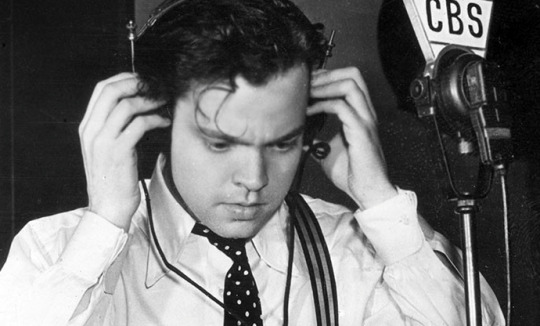
3. Voice on the Radio
Though famously a devotee of the Baird, Welles' recognition was earned by his incredible command of the airwaves. Welles' famous baritone voice became a regular mainstay across America as he became the regular voice for many of the country's most popular radio dramas of the time.
At the age of 21, Welles produced an acclaimed and often criticized version of Hamlet he did for the Colombia Workshop that shaved the four-hour play into a two-part 59-minute audio drama that cut the story of the Shakespearean tragedy to the bone. His presentation was noticeably more emotive than most presentations of Shakespeare at the time which set him apart.
The bread and butter of his work throughout the 1930s was his work on pulps and radio dramas. Throughout 1937 over the course of a year, Welles provided the voice for the pulp icon The Shadow. At that point, the vigilante pulp hero in question was one of the largest entertainment properties of the time with novellas and regular radio dramas dedicated to him every week. Having Welles take up the mantle for a time put the fledgling star in the seat of a pop icon.
The moment that shot Welles into the spotlight came on October 30th, 1938 when Orson performed what would become the greatest media scandal of his career with the infamous War of the Worlds broadcast. The adaptation he conceived was fascinating. He took the broad events of H.G. Welles famous science fiction novel and interpreted them in the form of a series News broadcasts as though the events of the book were happening in rural New Jersey and New York City. The following events aren't clear. Welles himself inflated the reaction to the broadcast as though hundreds of screaming civilians scurried across New York City and attempted to flee head first into the Hudson River. More than likely the reaction caused nothing more than a minor stir compared to the massive nationwide reaction that the broadcast was implied to have caused. The broadcast itself did advertise itself on the pretense that it was a radio drama so any disturbed civilians would've tuned in later into the broadcast without the knowledge that it was a radio play. The incident was taken seriously by the United States government and Welles was forced to own up to the brief chaos. Next to his first film, this incident would become the most widely remembered moment of his career and one he took a perverse pride in. Beyond the angry government officials, it caught many an important eye of the day. Among the people who took interest in Welles were the producers at RKO Radio Productions in Hollywood.
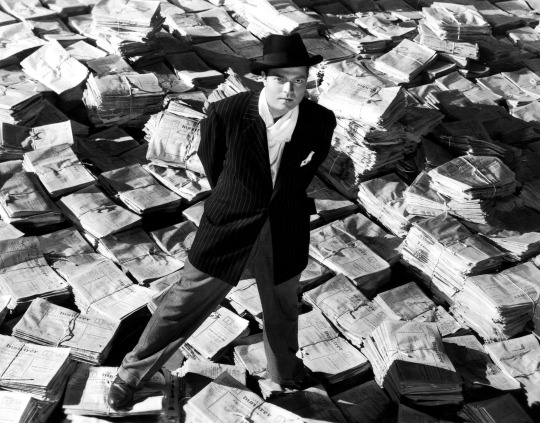
4. Sought by Hollywood
Welles initially had no interest in film or Hollywood. Hollywood wanted Welles because he was an exploding star with exactly the sort of talents and celebrity that could transition into a film career. RKO Radio Pictures approached him with enormous monetary offers but the disinterested Welles was already wealthy. Money was no object to him. If he was going to be dragged into the film industry he was going to do it on his own terms. Thus he sent RKO an over the top ridiculous offer demanding full creative control over whatever he produced with them. To his surprise and the surprise of the enter Hollywood establishment, RKO accepted. He was offered a multi-picture deal with full creative control, upto and including hundreds of thousands of dollars to spend on each film and the right to reserve showing the picture to the studio executives until it was completed.
This has to understood in context. The late 1930s was the height of the studio system in Hollywood. Filmmakers worked at the behest of cutthroat corporate masters who had the right and gumption to control every facet of a film. They frequently re-shot segments from acclaimed films before they're released on a whim based on what they thought worked/didn't work/was marketable by their standards. Even industry greats like John Ford and Frank Capra didn't get to control this much of their films. Given that creatives had so many restrictions the results were stunning. This was the moment in cinematic history when films like Casablanca, The Wizard of Oz and Gone With the Wind were emerging and defining the Golden Age of Hollywood as a time when storytelling and craft were at their creative peaks. For Welles to gallivant into Hollywood and take over the town single-handedly was unheard of. To paraphrase Welles, he had been given the greatest train set a kid ever received and he was looking to use it.
Without knowledge of what he was even doing Welles immediately turned to the greats of the industry of the time to start building his team. His two most important collaborators would be screenwriter Herman Mankiewicz and cinematography Gregg Toland. Mankiewicz was a veteran screenwriter who had had his hand in writing and producing dozens of films since 1926. Toland was fresh off of working on multiple critically acclaimed films like The Long Voyage Home and The Grapes of Wrath, both of which he shot with John Ford.
Welles had the best talent Hollywood had to offer at his fingertips and near infinite power to do as he pleased and began working on different pitches for ideas for his first film. The first idea he conceived was ultimately too ambitious to achieve. He considered shooting an adaptation of Joseph Conrad's Heart of Darkness done in the first person perspective. The project ultimately fell apart as Welles eventually couldn't make his vision work on RKO's budget. Decades later there was a proper if highly altered adaptation of the book with Francis Ford Coppola's Apocalypse Now.
Heart of Darkness would be the first of three pitches Welles initially made to RKO to fill his two film contract. His second idea was a political thriller/comedy called The Smiler With a Knife based on a novel by Cecil Day-Lewis. This project stalled by December of 1939. Welles was uncertain of a plan and didn't want to drag starting production on something indefinitely. He was already behind schedule. Welles and Mankiewicz began brainstorming and eventually, the two started on an idea for a film titled American. Welles approached Mankiewicz during the writing to find that the script he'd written out was hundreds of pages of messy but serviceable ideas. Taking his excellent ability to cut down stories to the bone that he had used on Hamlet, Orson crafted what would come to be known as his first masterpiece Citizen Kane.

5. Citizen Kane (1941)
I recently did a full-length breakdown of Citizen Kane for Geeks Under Grace and don't wish to relitigate much of what I produced for that article here. What I do think is necessary is understanding how the world reacted to and would ultimately go onto understand the film.
The reaction to the film was both immediate and faltering. The film was met initially by mixed reviews that sited the film's awkward structure as a fault. It wouldn't be years before the film would be released after it's initial run that the film would be subsequently analyzed and relitigated as one of the greatest films of all time.
Well before it's release, the film's satirical target William Randolph Hearst heard the wind that the film was a rather overt critique of his person and attempted to buy the film outright from RKO Radio Pictures to prevent it from seeing the light of day. When that didn't work, he turned to his newspaper network which proceeded to lambast the film in the public eye. The film's release was delayed and by the time it released to the public the reaction was nothing more than a whimper. Citizen Kane bombed in the box office.
The half-century of after it's release brought much rabid discussion and reevaluation of the film into mainstream discussion. In a famed piece of now hotly disregarded film criticism, New Yorker Film Critic Paeline Kael wrote Raising Kane. The essay lambasted Orson Welles, the film in question and called into question the very authorship of the film, claiming that screenwriter Herman Manchowitz deserved more credit for his role in writing the film.
Mind you Pauline Kael's criticism wasn't totally irrational. Kael is one of the most influential critics in history and tends only to be remembered nowadays by her gaffs like her public disdain for Clint Eastwood films like Dirty Harry. Her coming out against Orson Welles is remembered as an enormous artistic mistake on her part but people take the book-length essay she wrote very seriously. As a point, it's worth noting that Welles fundamentally agreed with her on many points. He felt that the director was an overrated position in filmmaking and that film was a collaborative process between the writers, actors and crew that the direct guided and oversaw. Even so, it's not surprising one of the antagonist characters in The Other Side of the Wind was a female film critic.
The most cynical read on Citizen Kane is that it's the film that introduced the concept of ceilings to the cinema. Prior to Citizen Kane, most film productions didn’t film ceilings because they needed open air sets to fit audio equipment. Many proclaimed fans of the film tend to adore it's superficiality more than it's actual storytelling chops as a film. As it stands the most remembered aspect of the film is the Rosebud twist at the end that Welles himself considered as gimmicky. Welles himself had a very conflicted relationship with the film. Welles disliked some of the films minor mistakes and ultimately came to consider the film a curse on his career that he could never live up to. How can anyone build a career off of an instant masterpiece? Even the man who made Citizen Kane couldn't manage to answer that question.
Yet in 1982, Steven Spielberg paid $55,000 for one of the surviving Sled props. Every filmmaker from Martin Scorsese, to Richard Linklater, to Tim Burton, to George Lucas and the aforementioned Steven Spielberg has sited Citizen Kane not only as one of their favorite films but as their inspiration for much of their work. In addition to most every respected film critic from Roger Ebert to Jonathon Rosenbaum has offered their endorsement of the film's strengths. Its legacy is undeniable. Is it overrated? Perhaps. While it's placement in the canon of Orson Welles is certainly hotly debated, there is no denying that Welles began his filmmaking career with a masterpiece for the history books.
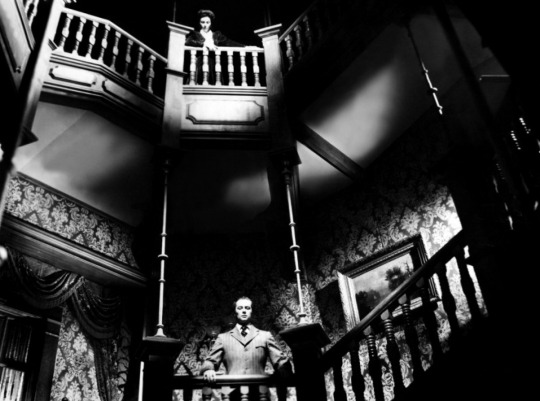
6. The Magnificent Ambersons (1942)
There is a scene in Richard Linklater's Me and Orson Welles where the titular character and his apprenticing young actor Zac Effron that the Welles family was once close to Booth Tarkington. Though not widely remembered today, Tarkington would've been a huge deal to people at the time much how writers like Cormac McCarthy and David Foster Wallace are lionized today. His masterpiece The Magnificent Ambersons would go on to be the subject of Welles’ second major film for RKO.
As Welles continued his work after the debacle of Citizen Kane's release he quickly moved on to fulfill the second film in his RKO contract. His team continued to dig through numerous options and ideas. The most notable idea he didn't end up going with was a pitch for an adaptation of the Bible called The Life of Christ which would've been a strictly adhered adaptation that ultimately fell through twice. Instead, Welles turned to the contemporary masterpiece that was close to his heart. Welles' initial cut of The Magnificent Ambersons is said to have been a masterpiece that rivaled Citizen Kane in quality. He translated the sad story of an old American family's decline into poverty and irrelevance to the cinema and delivered the second masterpiece RKO paid him to. Unfortunately for Welles, it wasn't the masterpiece RKO wanted. The studio shuttered at the bleak film Welles had produced and quickly began underhanded plans to change the film.
Welles was shipped off to Brazil as part of a US Government deal with their government. He was to shoot his third feature for RKO called It's All True which would've involved documentary footage from various festivals and events. While he was out of the country, RKO pulled all of the actors and crew back to the studio lot, cut out the third act of the film and reshot it with a happy ending that completely changed the story of The Magnificent Ambersons. Several cast and crew attempted to warn Welles but he didn't find out until it was too late. By the time he was back in Hollywood, he would lose his rights to change the film.
Late in his life, Welles would find himself watching the theatrical cut of The Magnificent Ambersons late one night on television. His then mistress Oja Kodar recalled the experience of nearly walking into the room and catching a reflection of the late 60s Welles sobbing as the movie that clearly meant the most to him was presented on late night television. While the cut we have today is largely excellent, it's far from the vision that Welles had intended for it.

7. Fired from RKO
Welles had already been fired from RKO Radio Productions by the time he returned from Brazil. The studio that had once promised him free reign to produce masterpieces for them didn't like the controversy associated with his films and couldn't figure out how to market what he did film. For them, it was smarter to go into damage control mode and boot out the wunderkind to the streets. The cut of Magnificent Ambersons with the happy ending they did produce didn't do well in theaters and the preferred cut of the film was eventually destroyed. Thus began the air of bad luck that would surround Orson Welles' prolific career. Despite churning out two masterpieces, Hollywood now hated him. As time would go on he would become more and more of a pariah in filmmaking circles.
His last film for RKO which he was producing and directed several scenes for Journey into Fear ultimately saw him being stricken from the credits. His co-director Norman Foster would receive directing credit but later Welles scholars have often retroactively credited Welles as a director too. Welles immediately began damage control for his reputation by prostrating himself over the next several film projects he produced. He started taking acting jobs for films starting with an adaptation of Jane Eyre to try and repair his public image. Interestingly enough the latter film would end up being one of his only romantic performances as that film had been produced to capitalize off of the recent success of historical romances like Gone With The Wind.

8. The Stranger (1946)
Welles needed to jump back into Hollywood and prove that he was capable of producing something normal that he could sell. With that in mind, he conceived of The Stranger. The film would go on to be his least artistic and therefore most financially successful film. It had been four years since he'd been in the directing chair and he was desperate. He was approached by producer Sam Spiegel after director John Huston couldn't take the job. The result is easily the most Hollywoodish film of his filmography and the one that really represents the director at his most obedient. Despite the darker story, that being about a Nazi holocaust perpetuated being hunted by an investigator portrayed by Edward G. Robinson, the movie was a great deal less artistic and revolutionary by the standards of the time. It was merely a conventional noir thriller. To paraphrase Welles, he did the film with much stricter regulations as a means of proving to Hollywood that he wasn't a toxic director and that he could make money. While the film wouldn't succeed in fixing his reputation it at least made him slightly less toxic. Unfortunately, the film wouldn't lead to any additional career help for Orson. He originally signed with International Pictures to do a four-picture deal after the film as complete. The company backed out of the deal the just weeks after the premiere when it looked initially like the film wouldn't make it's money back.

9. The Lady from Shanghai (1947)
The life of Orson Welles has often been described as an illusion, an incestuous juggle between fact and fiction that the ever impressive Welles maintained as a kind false mysticism to increase his legend. While it did give his persona a larger than life appearance it's made tracking the history of Welles into a nightmare. This can be clearly seen in the case of Welles' third masterpiece The Lady from Shanghai. He's told the story of how he pitched the film to Hollywood producer Harry Cohn of Colombia Pictures. After his recent failures Welles turned back to his previous loves of radio and theater and began producing new shows and dramas. His biggest stage production at that point was a play version of Around the World in 80 Days which closed almost immediately within weeks after opening.
Supposedly, as the production was preparing for it's Boston premiere, Welles found himself strapped for cash and in desperate need for $50,000 to move the costumes from the train station to the theater. Desperately he pitched a fake book to the president of Colombia Pictures using the name of a paperback book a young woman was reading next to him, got the money, performed the show and then went back to Hollywood to write and direct the film. It's a great story but it likely isn't true. Whatever truth is in it is questionable as he's told different versions of the same story to different interviewers, each with a different amount of money and circumstance. It's likely that Welles just got called out of the blue by Harry Cohn to direct a thriller and he took the gig. Naturally of course half of the appeal of Orson Welles is the blur of fiction and reality the surrounds the myth of his life. It's fun to speculate but having a historically accurate read of Welles' history is a frustrating knot to untie for scholars.
That film he produced The Lady From Shanghai would become one of his most respected films and widely regarded as one of the weirdest movies. That's not hyperbole either as David Kehr of the Chicago Reader was quoted as saying it was one of the "weirdest great movies ever made". While more conventional by the standards of his previous two masterpieces, The Lady from Shanghai is far from your run of the mill Noir thriller. Welles had initially shot the film in the style of a documentary. That's a strange choice but it grounds the otherwise outlandish story of a sailor being asked to help fake the death of a wealthy man in a kind of distant visual style. Harry Cohn hated the result. Like his previous two films, large segments of the film were reshot to add traditional close-ups and conventional shooting. These shots clashed with the film's already strange visual style and made the film more surrealistic than it already was. The film's most notable contribution to cinema, of course, was the finale in the mirror maze. Without spoiling the story context, the final shootout is mesmerizing and visually bizarre and left an imprint on generations of filmmakers. The trope has returned in numerous forms from action films like Enter the Dragon and John Wick 2 to comics like The Dark Knight Returns. Yet again though, the film flopped in the box office.
As a quick aside, the film also stars his then second wife Rita Haworth with whom he divorced shortly after the film completed production.
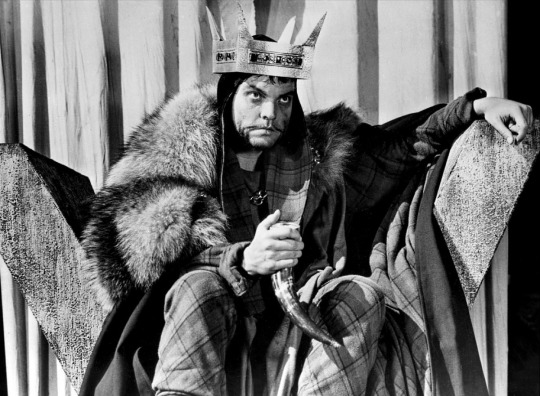
10. Macbeth (1948)
It's strange that Welles' first attempt at a Shakespearian film would come about in such a modest fashion yet his selection wasn't surprising. Being that Voodoo Macbeth was the stage play that put his name on the map, a traditional Scottish production on film made sense to be his Shakespeare film.
Republic Pictures at the time was a subpar studio by the standards of the Big Three. It mostly produced B-Pictures and serials. For Herbert Yates, as the president of the studio, Welles' pitch for a Shakespeare adaption gave him high hopes that he might be able to make his fledgling Hollywood operation into a prestige studio with the right success and went all in on the idea. Welles produced the film on cheap sets and finished the film in just 19 days of production with two additional days of pick up shots. Yet despite being rushed and inexpensive, the film managed to produce something qualifying as a definitive vision of one of Shakespeare's most famous tragedies. That speaks highly of the production given that the play has been adapted dozens of times in cinematic history including versions by Roman Polanski, Akira Kurosawa and most recently Justin Kurzel. Yet Welles' film was benefitted by Welles' unique expressionist take on filmmaking. The cheap stagey sets were masked in beautiful black and white film stock, lit with precision to highlight it's character's emotional state and performed to perfection with Welles in the central role.
Welles had bet that the film would go a long way to repairing his reputation and unfortunately this wouldn't help it. The film was savaged by American critics who despised the over-the-top Scottish accents in the initial release. Welles rerecorded the dialog with American accents for a 1950 rerelease but that version didn't do well either. Both versions were flops and outside of Europe where the critics appreciated it more, there wasn't much support for it. It didn't help that the film was released in close proximity to Laurence Olivier's acclaimed Hamlet which became one of the most celebrated Shakespeare adaptations of all time. It would take years for critics to start appreciating its strengths.
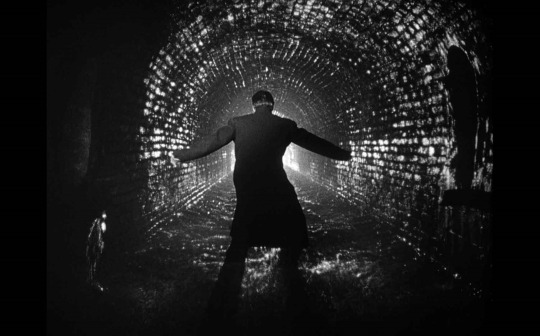
11. The Third Man (1949)
Of all of the films in the Welles filmography, maybe none is more vital to understanding the Celebrity of Orson Welles than The Third Man. Like Jane Eyre, this wasn't a film that he produced or directed in so much as he is remembered for his excellent performance. At that, he's barely in the film at all. The leading man is his frequent collaborator Joseph Cotton. The film was directed by legendary director Carol Reed, famous for films like Odd Man Out, Night Train to Munich, The Fallen Idol, and Oliver! While somewhat obscure now, the director became famous for being one of the most skilled directors in British history. In addition, the film was produced by legendary golden age producer David O'Selznick (Gone With the Wind, King Kong). Welles was asked to play the role of Harry Lime in the film and was offered one of two options for payment for a small role. He had the option of reviewing a portion of the film's profits down the line or a lump sum of money immediately. In a moment of deprivation, he jumped on the money immediately in a financial decision he would come to regret. The Third Man would go on to become the most financially successful film he was ever associated with. Had he chosen profit sharing he would've become immensely wealthy as the film in question has remained one of the most popular noir thrillers of all time.
Welles would later go on to express his opinion that his performance was the greatest "Star" role an actor could've ever asked for. Harry Lime is mentioned dozens of times in the film prior to his first appearance so when Orson Welles finally makes his surprise splash of an appearance the film there is a great deal of weight to his screen presence. His few scenes in the film and his improvised line are usually sighted as the high points of an otherwise widely regarded film. In some ways, this is sadly prophetic of much of the way culture remembers Orson Welles. People think of him as a flash in the pan and we see this in the way culture idealizes individual moments from his films as opposed to his films overall. Most people don't remember the side characters in Citizen Kane but they remember Rosebud. The same is true of The Third Man. People remember Welles' few scenes but they frequently forget Joseph Cotton and Carol Reed's accomplishments with the film outside of Welles. The mere size of his personality creates expectations. First-time viewers familiar with Welles might be surprised to notice he doesn't appear until well after the first hour of the film. Welles is just one turning gear in a much larger story about post-war corruption and profiteering set against the hurt and ruin of Vienna, Austria. His chemistry with Joseph Cotton adds an air of history two the two characters whose lives were once tied together being torn apart by circumstance. His deep baritone voice exudes an air of malevolence as he stares contemptuously on the small people below him. It's a small but vital performance built up to by one of the greatest thriller stories of all time.
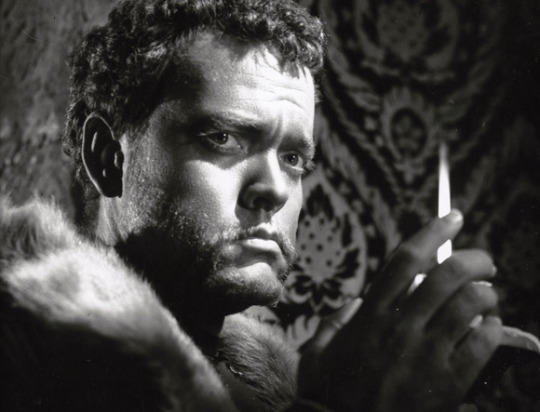
12. Othello (1951)
No film would come to break Orson Welles' reputation more than Othello. Despite earning the Grand Prix du Festival International du Film at the 1952 Cannes Film Festival, Othello would become a curse on his reputation that he would never overcome. Welles had conceived of doing an adaptation of Shakespeare's Othello prior to Macbeth but ultimately chose to go with that play when the concept seemed unfeasible. Welles was approached by an Italian film production company to star and direct a film version of the famed play based on his recent theatrical work which the production company thought would translate over well into the stage play. Welles quickly got to work assembling a team of European filmmakers and actors that he took to Italy. The production was immediately stymied by the surprise Bankruptcy of the production company meaning that the subsequent three years of production necessary to get the film finished had to be self-financed. Though not Orson's fault as the factors were out of his control, this would prove to be the final nail in the coffin of his public reputation. The fact that the film took three years to finish and went over budget put a stigma on his name that he never escaped.
The result was a convoluted production shot across multiple countries including Spain, Italy, Morocco and Turkey that created a mismatched pan-Mediterranean look to the film. The final cut was an atmospheric masterpiece. Welles scholar Jonathon Rosenbaum described the tone as almost that of a horror film more than anything else. There's is an immense dread hanging over the film as we see the unfolding story of interracial love and racial bigotry play out against the backdrop of war and political strife. While a clean cut is available today thanks to the Criterion Collection, early distribution of the film didn't go well. The film received several cuts in different countries and many of the versions distributed had massive audio problems including audio drops and syncing issues. The film was also distributed with multiple soundtracks. Once again the hard work that went into an Orson Welles film was lost to circumstance and failed to materialize until much later.
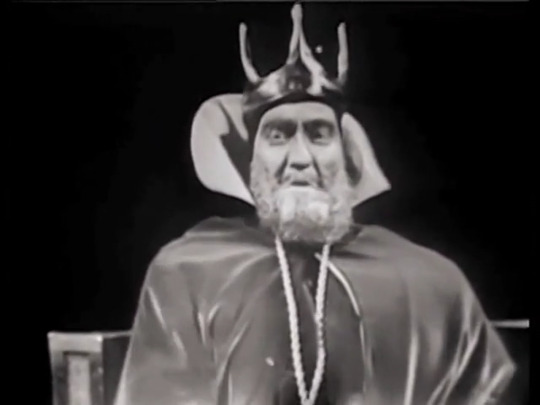
13. King Lear (1953)
In the second of Welles' exoduses to Europe, the director fled the United States for England following the McCarthy hearings and as a result put him on bad terms with the IRS. Orson Welles wasn't a communist but he was a Roosevelt Progressive democrat and disliked the air of paranoia in the United States during the Cold War. Welles was asked to perform the titular role in a CBS Omnibus production of King Lear for television in 1953 which he accepted the role of. The television film was a severely truncated 73-minute version of the play with most of the subplots and extraneous stories outside of the main plot cut out to focus on the main character's descent into madness. Though cheaply produced for television, his performance as Lear is the standout of the film. While he was in the United States to film the production, he was escorted every by the IRS who confiscated his earnings from the production to pay off outstanding taxes being sent back to England.
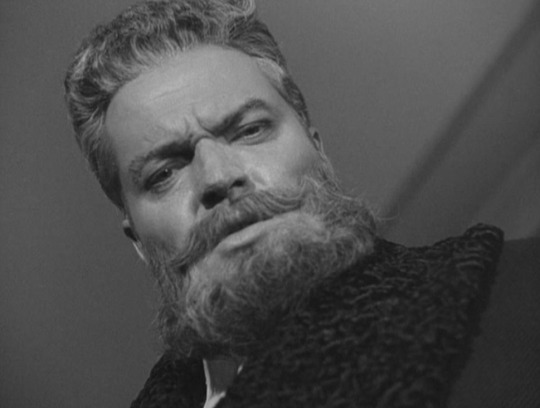
14. Mr. Arkadin (1955)
After the immense success of The Third Man, the movie that had taken Hollywood by storm became a hot ticket item and it's producers wanted to franchise it. Thus in 1951 was born The Lives of Harry Lime. The radio drama starred Welles in his most popular and deplorable character over the course of 52 episodes that represented a prequel to the film. Welles himself was involved in the process of developing the series given that the character was so directly tied to him. This included an episode called The Man of Mystery. This episode would go on to become the primary influence of Welles' newest thriller.
Though lower in budget, Mr. Arkadin was ambitious in its scope. The thriller sought to be a massive thriller set across multiple countries where the stakes of the questions it raised could change the fate of nations. In terms of story, this thriller was one of his most grand and globe-trotting adventures. Mr. Arkadin is a veritable tour de force of settings and European cultures.
Whereas Othello was shot over multiple countries meant to portray the same place, Mr. Arkadin was set across multiple countries in Europe and portrayed the variant beauty of many of it's finest interior sets. Cramped as much of the film looks from a visual standpoint the film did tour Europe across the scope of its production from London, Munich, to multiple places in France and to Switzerland. The story's central mystery involving the investigation of a man with no memory of his past can be difficult to follow but builts to an excellent final race wherein the lead character and the titular Mr. Arkadin must race to Spain to find the same person before the other.
Once again he lost control over the final cut. The postproduction became a trainwreck worthy of Orson Welles' reputation. As scholar Jonathon Rosenbaum discussed in his famous 1991 essay Seven Arkadins, there are no less than seven public cuts of Mr. Arkadin. Welles lost control of the editing process and rights to the film when he missed his deadline and as a result, the producer recut the film multiple times, novelized it, and gave it several releases across Europe in multiple languages. Welles had been reshaping the story and structure during the editing process to improve it and without his guiding hand, the final edits that made theaters were fare from his wishes. Welles would go on to consider the film the greatest disaster of his career. He was a man who suffered many indignities but the utter loss of Mr. Arkadin to multiple cuts was one of his most brutal defeats.
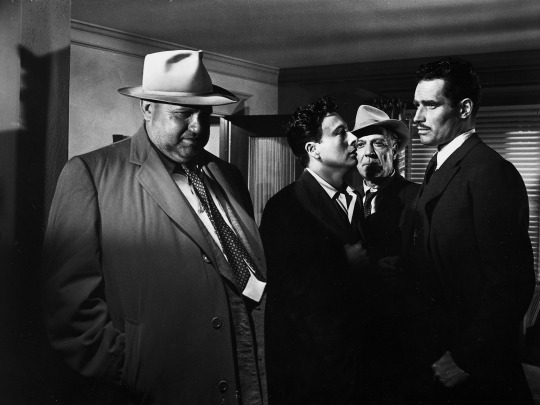
15. Touch of Evil (1958)
Welles had just finished acting in a thriller for Universal Pictures when he was asked by the producers to perform in another film for them as "the heavy" in a crime thriller. Universal was already far underway in developing the story concepts and casting but hadn't settled on a director or a script as of yet. Charlton Heston was already picked to play the lead role in the film. During a cross-country phone call, the film's producers mentioned the casting offer for Orson Welles when Heston made the offhand comment that Welles ought to be the one they sought out to direct the film based on the quality of his previous films. The line went dead for several seconds.
Welles was just getting back to Hollywood after a decade away in Europe. While he hadn't gotten over the pain of his bad breakup with RKO and his previous failures he was eager to direct a Hollywood picture again. Welles signed up to Touch of Evil at Heston's behest on the stipulation that he would get to rewrite the script. Over the course of several weeks of late nights, Welles and his secretary chugged out a new script based on the book Badge of Honor that Universal approved and set to work on.
As with many Welles films, Touch of Evil is rather depressingly remembered primarily for its opening shot. The several minutes long tracking shots at the beginning of the film is legitimately excellent in its pace and scope as we see several minutes of a car with a ticking time bomb in the back seat slowly drive across the US-Mexico border through crowded streets knowing the car could explode at any moment. Naturally of course when I was shown the film in Film School this is where the film was stopped. Many filmmakers worship the tracking shot and then forget to watch the remaining film. What they miss out on is a dark tragedy of corruption and falls from grace. The murder we see play out in real time at the beginning of the film is merely the beginning of a much larger conspiracy as the bombing rouses the attention of a Mexican police officer in the area at the time on his honeymoon and the local police legend Hank Quinlan. The film is one of the starkest examples of contemporary film noir, making the most out of Welles' expressionist love of shadow and darkness. While the opening shot is excellent it's not even the only tracking shot in the film. There are several long tracking shots, several of which we see during the investigation scenes that are just as technically impressive considering how deeply we follow the camera and swing in, out and around the conversations at play.
Universal had loved much of the footage that Welles was sending them at the end of every shooting day. Right up until they saw the rough cut of the film it seemed as though the two parties were on the same page. Alas, Universal Studios did what Hollywood always did to Orson Welles films. The final cut scared Universal with how dark it was. They cut out half an hour of footage and reshot segments of the plot to make it more palatable. By studio contracts, they had to present Welles with a cut of the film before the film went to print and shipped off to theaters. After seeing the new theatrical cut, Welles was distraught. The perturbed Welles skipped out on his daughter's wedding to write a 58-page memo to Universal Studios begging them to make needed changes to the film.
The film was released as the second billing of a double feature and subsequently bombed. In Europe, the film received a surprising level of acclaim, support from major film critics and won two awards at the 1958 Brussels World Film Festival but without American success the film as considered dead on arrival. This was the last straw for Orson Welles. Hollywood had betrayed him for the last time. With this last indignity dealt to his creative vision, Welles packed up and moved back to Europe again.
There would thankfully be something of a re-edit of the film. In 1998, acclaimed film editor and sound designer Walter Murch (Apocalypse Now, The Godfather Trilogy, American Graffiti, The Conversation, The English Patient, Jarhead) recreated a special cut of the film based on the Welles memo that represents the closest version of the film to Welles' vision that remains the definitive way to watch the movie today.

16. Exile to Europe
Immediately after the debacle of Touch of Evil, Welles began to work independently on one of his most ambitious and personal projects to date. Don Quixote would go on to become one of the great obsessions and failures of his life, never seeing a proper cut released. He started accruing footage immediately after finishing his work with Universal by doing some shooting in Mexico. He would continue this process over the course of the next two decades, doing what meager shooting he could across multiple countries in Europe. Unfortunately, time dragged on and the loss of actors to death dragged the film's post-production well into the 1980s without having completed principal photography.
As Don Quixote continued to meld and atrophy, Welles began the next stage of his life by beginning something of a new chapter in the history of cinema. Without the backing of Hollywood money or big investors behind him, Welles began a personal journey as what we would be known as the first truly independent filmmaker. His subsequent series of European films, though cheaper looking and rough around the edges, represented some of the only items of his career that he felt truly proud of in their totality. They were totally his films, unedited by intrusive producers seeking a buck and all celebrated across the European arthouse film scene. Of these, in his later years, he was the proudest of.
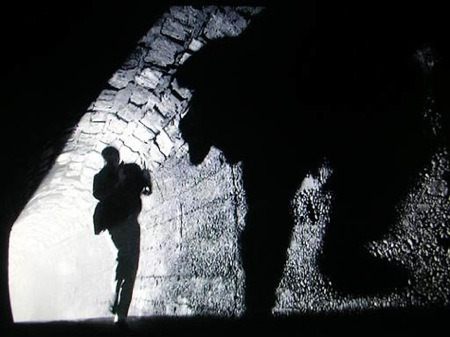
17. The Trial (1962)
Literature was, of course, the love of Welles' intellectual life. He was well read by anybody's standards by the time he reached New York City in his twenties and started adapting Shakespeare better than Broadway was at the time. He understood these great works of literature greater than almost anyone else that had the bravery to take a straight edge to them and crave new versions of them for viewing audiences. Often that meant that his versions diverged from the ideas inherent in the text while still staying true to the spirit of the literature. In the case of Franz Kafka's book The Trial, the story of an innocent man trapped in a bureaucratic cycle of hellish corruption and repetition becomes a different kind of nightmare. To borrow Welles' quote, "He's guilty as h***!"
Welles' monologue at the beginning of the film refers to the story as having the logic of a dream. Seeing the film one can recognize that immediately. The setting, production design and moment to moment logic of the story shifts with surreal precision from moment to moment as the lead character Joseph K. is dragged through a strange inquisition, blamed for a crime that is never explained to him bursting with fear and guilt the whole way through. The film looks and acts like a nightmare, as the scene to scene flow arbitrarily jumps from scenes of stark visuals, tense chases, and heavy shadows. Never before or after has Welles' overt love of expressionism been put to such beautiful use. Then again it's hard to tell where the movie begins and the budget ends. Much of the film is shot against industrial blight as we see buildings lined with electrical wires and technology. It's a strange look that contrasts with the sleek, fast-paced cinematography at times. It's never clear that Welles isn't just shooting this at the first industrial park he could find that was available or if these flourishes of ugly utilitarian electronics are part of the point. Maybe they're expressions of the bureaucratic machine that is chewing K alive.
Of all his successes, The Trial is the one that Welles has gone on record as saying was the greatest thing he ever created. Beyond the constraints of a low budget, everything we see on screen is Welles' vision. Given the years of hardships that incurred his previous productions, it's not surprising he'd hold a film that represented his own vision in such high esteem. That said, The Trial wasn't the film that he considered his favorite.
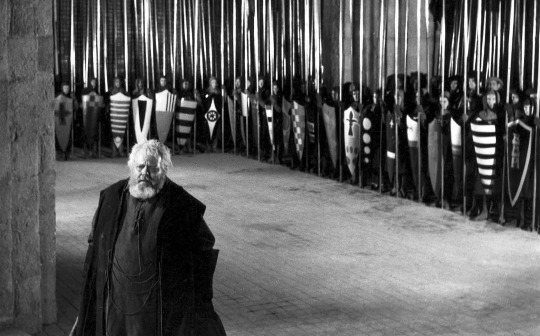
18. Chimes at Midnight (1965)
Welles once said in an interview that if he ever had to argue his way into heaven based on his work, he would try to do so with Chimes at Midnight. Originally titled Falstaff in some regions after the central character, Chimes at Midnight represented the most loyally produced and loving adaptation of Welles' own career. It was based primarily on William Shakespeare's Henry IV Parts 1 and 2 with elements of Henry V added. For Welles, the book's central character of Falstaff, the jolly, rotund and disgraced nobleman was one of Shakespeare's greatest creations. Naturally, Welles saw a great deal of himself in Falstaff. The character was by his nature a good man, albeit a lusty, cowardly slob and a liar with a heart of gold. He was innocent and naive in the manner of a child. To Welles, he was the representation of Merry Old England and the fictionalized nostalgia for the past that imbibed so much of English literature from Shakespeare to Chaucer. He was an implicit rejection of the notion of modernity. Welles had tried before to stage a version of what would become Chimes at Midnight earlier in his life called Five Kings that ultimately proved too technically complicated and slow-paced to work properly. With Chimes at Midnight, Welles finally achieved a lifelong dream in portraying his favorite Shakespeare character in all of his exhaustive glory.
Much like The Trial, there is much to be desired about Welles' vision for medieval England. The claustrophobia and tension of his previous film gave way to vast open spaces, joyous celebrations in wide open inns and regal grandeur of the Royalty. Henry IVth is the story of the aged father passing down his title to his namesake son and forcing him to grapple with leadership and responsibility. For the young Prince of Wales, King Henry and Falstaff are the literal representatives of his duality between responsibility and youth. It's a kind of tragedy of maturity wherein Henry must put aside Falstaff and grapple with the brutal realities of the real world. Naturally, Welles goes on in on that brutality. Chimes at Midnight comes with one of the most brutal and influential battle scenes in cinematic history. The carefully shot battle scene incorporated dozens of extras, horses, and grime to produce one of the least romantic depictions of battle yet put to film. Welles said the battle scene was meant to be intentionally brutal to emphasize the idea of the death of chivalry in battle. We see that clearly as swords clash and bodies pile up. Visually speaking it's hard to deny that the battle wasn't hugely influential on generations of filmmakers, being referenced in everything from Kenneth Branaugh's adaptation of Henry V to Mel Gibson's Braveheart and even in the Battle of the Bastards in Game of Thrones.
Naturally, a shoot of this size and scope proved to be greatly difficult on Welles' budget. Europe is naturally awash with castles so locations proved to be available for the film's striking scenes set against the Royalty. Most of the shooting in the Inn was done on a sound stage that Welles had built specifically for the production. Unfortunately, the film lacked proper audio recording technology requiring nearly all of the audio to be rerecorded in post-production. Despite the limitations, the final product is staggering to behold. It's a loud, boisterous and joyful tragedy right up until the bitter emotional end. Many critics consider Chimes at Midnight to be Welles' greatest achievement above and beyond Citizen Kane. Welles would be inclined to agree.
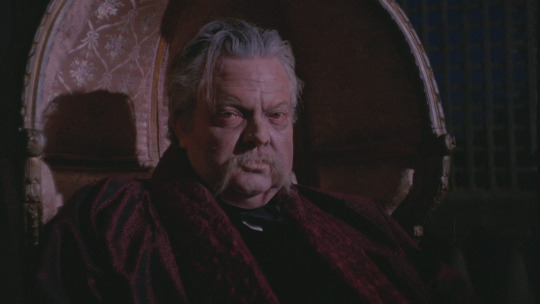
19. The Immortal Story (1968)
Of all the films in Welles' filmography, none represents quite as massive of a digression as The Immortal Story. Immediately the viewer notices that the film is his first film up until this point that was shot in color. As Welles discussed with his protege and biographer Peter Bogdonvich, he always preferred to shoot his films in black and white as he felt that the format did more to help present performances better than color did. With The Immortal Story, he seems to have broken his rule for reasons that aren't quite clear. The results offer some hints as to what was going through Welles' decision-making process. The film is bizarrely alluring to look at. Considering his visual style was more receptive to surrealism and stark visual symbolism, a cursory review shows the film to be one of the most luscious and beautifully shot films in his filmography.
With an understanding of the story, the logic of this seems to come into focus. The story follows the life of an ancient European nobleman who in his older years has sought to make a story that he once heard come true. In the story, an old man pays a sailor five guineas to have an affair with his life before sending him off to sea. Fulfilling the story and making it a true story becomes the old man's obsession. Paying an older fellow Noblewoman and a young sailor he meets on the street, the man observes from a distance as the scenario he contrived into reality forms as the Noblewoman and the sailor bond and intimately perform their task before they're forced to part ways.
While sexuality does technically exist in several of Welles' films like Citizen Kane and The Trial as plot points, The Immortal Story holds the bizarre position of being one of the only Welles projects wherein sexuality is a major theme of the story and one rooted in its story's ideas and anxieties. One can almost look through the allure of its technicolor dreamscape and intimacy to see a depiction of Welles' vision for what the very nature of storytelling is. Through the shrouds of more traditional filmmaking, Welles seems to be using this story as a kind of metaphor for the drive and anxiety that forms storytelling itself. At its core, Welles seems to suggest that the core of art is a perverse need to reproduce and express one's innermost anxieties on display. Though unconventional and likely overly sexualized for some viewers, The Immortal Story presents us with a disturbingly honest sort of autobiography of the artist's soul.
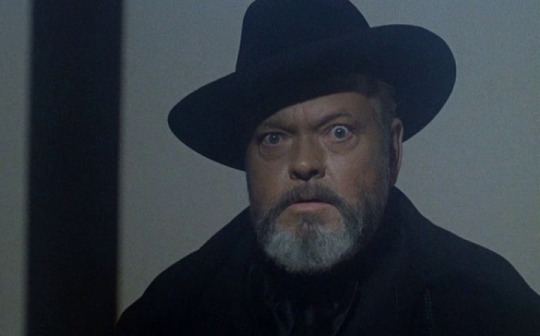
20. F for Fake (1974)
Orson Welles' final completed film represents one of the most avente-garde and experimental pieces of filmmaking in his filmography. F for Fake is technically a documentary but it's a very fast paced, tangential and esoteric piece of filmmaking that jumps across multiple boundaries and stories to explore multiple facets of a central theme. That theme is the idea of "fakeness". The central story follows a pair of famous frauds. The first is Elmyr de Hory, a Hungarian painter that made his living as an art forger recreating hundreds of the most popular pieces of contemporary artists including Pablo Picasso. The second is Clifford Irving, Elmyr's biographer who was caught forging an interview with the mysterious media mogul and recluse Howard Hughes.
While the story focuses primarily on their accomplishments and controversies the entirety of the piece is extremely tangential and jumps across the lives of dozens of people including Orson Welles himself. Welles takes time in the piece to discuss his history with lies, the War of the Worlds broadcast that he played up the legend of, how he got his first acting job by lying, and what the actual effect of lying means to the art world. Welles muses on the consequences of every one of the personalities he profiles and comes to many fascinating insights about the nature of their dishonesties. While he makes no bones about the fact that they were frauds, plagiarists and charlatans he also finds a great deal of sympathy to be found amongst the tragedies of their lives.
Then at the moment of most brutal honesty, he pulls back and asks what it all means in the scheme of things. Merely by observing a beautiful European church lined with hundreds of year old statues and garments of stone. He calls it a monument to human dignity and to God's grace and power. Yet this monument has no author or name to it. It merely stands the test of time as an expression of humanity's greatest desires and hopes. As essayist Kyle Kalgren noted in his excellent analysis of the film, Welles seems to come to the opposite conclusion of his seminal film Citizen Kane. "We'll always have Xanadu, so who cares about Rosebud?" Maybe the film's final conclusion is that art is greater than the individuals or money involved and that fake art is still art. Maybe a fake painting that matches the quality of the real thing is as valuable as the real thing. Then again maybe it doesn't. Welles ends the film with a beautiful story told by his then-mistress Oja Kodar detailing her family's lineage and the untold history of a great unknown art forger that represents one of the most exciting and beautiful moments of the film before Welles pulls the rug out on the audience with the film's final moments.
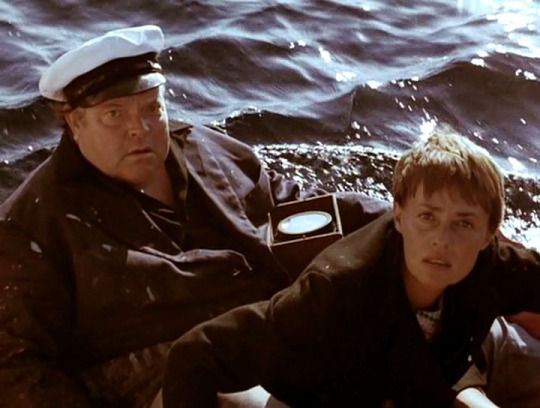
21. The Final Years and Unfinished Projects
The final years of Orson Welles' life can reasonably be described as a sad march into oblivion. Welles returned to the United States in 1970 hoping to find a home among the greats of New Hollywood and quickly set about trying to produce new films. What followed was fifteen years of financial breakdowns, gradual periods of acting in films for money and then turning around and investing it in his film productions. After 1978, Welles never completed a project for the final seven years of his life. Yet he still continued to work, taking acting and commercial jobs and desperately attempting to finishing his outstanding projects. His final completed projected was Filming Othello. The film is nothing more than a conversation of Orson Welles discussing the production history of his film Othello that he produced for German television. The film was included with the 2017 Criterion release of Othello and is well worth observation for fans of Orson Welles. If it impresses anything upon its viewer it would be Welles' strange sense of late-period melancholy and modesty. He states early in the film that nothing he's produced is worthy of the art that he's attempting to adapt and that he was merely a filmmaker. He would try to produce a second documentary called Filming The Trial but didn't complete it before his death.
He shot footage for multiple films in this time including an adaptation of The Merchant of Venice, a thriller called The Deep, segments of Don Quixote and finally his recently completed film The Other Side of the Wind. The latter of these he started on as early as 1970 and proceeded to shoot and editing throughout the remainder of his life. The film would go on to become the greatest legend of his filmmaking career. Despite six years of on and off production, nearly a decade of legal red tape following the Iranian Revolution (the film's financier was the brother in law of the Shaw of Iran) and years of faltering post-production, the film was never completed in Welles' lifetime. Prior to his death he discussed taking on directing several additional films including The Cradle Will rock, Ada or Ador: A Family Chronicle, Saint Jack (which his protégé Peter Bogdanovich would direct) and a full adaptation of King Lear.
There is a great deal of speculation about why many of these films never got done in the final seven years of Welles' life. Some consider Welles' final years to be too self-destructive and purposely unproductive but by all indications, Orson spent these years grappling with crippling financial troubles and red tape between his sparse moments of being able to film.
In a desperate move to try and garner sympathy and attention, Welles used an appearance during the AFI festival meant to offer the aged Welles with a lifetime achievement award for his work as a chance to promote his newest film. During the acceptance speech, he proceeded to show off footage from The Other Side of the Wind which was suffering from a lack of funding and wouldn't be finished and blatantly hinted that the film was short on funding. The incident was interpreted plainly as a moment of panhandling and desperation.
Welles wasn't a religious man and told two conflicting thoughts on his beliefs late in his life. On one occasion he stated that he was an atheist when asked to perform a prayer. On another occasion when asked he said that he believed in God but didn't think God would be interested in his prayers. In any case, Welles was apathetic to faith. His sole drive seemed to be his desire to create and act out the stories that inspired him and no one at this time wanted to respect or enable his talents. Unable to accomplish that which drove his life, his final years were spent in relative despair.

22. Transformers: The Movie (1986)
Orson Welles' final cinematic role was portraying Unicron in Transformers: The Movie. If there were any more of a modest place for the one time giant to descend, I cannot think of one. Granted this probably didn't represent his most serious compromise. During the production of The Other Side of the Wind, he spent several evenings with his cinematography editing softcore adult films so that the two of them could get back to work and keep him financially solvent. He recorded his audio for the film just five days before his death. Regardless of his opinion on working on the animated film, these final years of Orson Welles' life represent him at his lowest point. He was forced to take any gig he could book himself for. Famously he took an enormous amount of commercial work, which included an infamous Champaign commercial in which an inebriated Welles attempted to give an elegant speech about the mystique of Paul Masson wine only to slur his sentences to a depressingly hilarious degree. In his late period speeches, you really sense the desperation and melancholy of his station in life. As Welles performed his final voiceover on Transformers, his aged and decrepit voice proved too rough even to fill the role. The audio designers were forced to augment the voice-over performance to improve it.
Welles perished less than a week after performing his lines for the film from a heart attack at the age of seventy. He died at this desk while typing up stage directions for a project that he and his cinematographer Gary Graver were going to shoot the following day at UCLA. In a sense, he died doing what he loved. His body was cremated and a small funeral was held for him where in his closest friend and three daughters attended. This was the first instance that the three children of different marriages ever met. Two years after his death in 1987, his wishes were respected and his ashes were buried in Spain at the home of a friend and bullfighter Antonio Ordonez.

23. Don Quixote De Orson Welles (1992)
The years after Welles' death brought a great deal of pain and hardship for the people whose lives he most affected. It also brought a great deal of division and indecision. Depending on who you ask the following two decades after his death brought an enormous amount of hostility and contention between the inheritors of the Welles legacy. Multiple people sought claim to Welles' history and tried to make his works available. Since multiple studios owned the rights to his various films, rereleases of his movies became contentious. Universal was sued by Beatrice Welles when it attempted to reconstruct Touch of Evil only for his to settle out of court with the studio. She later claimed her suit was caused by a lack of communication that wouldn't have happened had she understood their plan to follow Welles' famous memo. Beatrice additionally caused a great deal of controversy in 1992 when she attempted to fiancé a restoration of Othello that many Welles scholars have come to scoff at for it's incompetent and sloppy restoration.
Cinematographer Gary Graver spent much of his life following Welles' death mourning the loss of his creative partner. Welles was his primary source of income and one of his closest work associates and friends for fifteen years. Graver would spend many of the final years of his life attempting to build a cut of The Other Side of the Wind that ultimately never came to fruition before his death in 2006.
Orson's mistress and creative partner Oja Kodar inherited the Welles estate and attempted to do everything in her power to preserve the memory and works of her lover. In 1995, she co-wrote/co-directed a documentary called Orson Welles: The One-Man Band. While she has settled into a comfortable life in Croatia working as an artist and an innkeeper, she's stayed notable through her association with her late lover. Depending on who you ask, she's responsible for some of the legal troubles that kept The Other Side of the Wind out of the spotlight, however, her role in preserving the later works of Welles is contentious. By any regards, Oja is a worthy inheritor of the estate and did everything she could to bring his films to the public light.
In 1990, she sold the rights to some of Welles' remaining footage from Don Quixote to Spanish producer Patxi Irigoyen, desiring to see some sort of version of the film come to fruition. Working with director Jesús Franco, the filmmakers stitched the decomposed footage shot across multiple formats into a semi-coherent two-hour film that they showed at the 1992 Cannes Film Festival under the title Don Quixote De Orson Welles. Without proper audio, the crew rerecorded dialog from new actors. The result is a rough looking, rough sounding and merely academic exercise that barely registers as a completed film. There was a rough cut that Orson Welles himself had finished that film critics Juan Cobos and Jonathon Rosenbaum have seen that according to them looks nothing like the hodgepodge of a film that Irigoyen and Franco assembled.

24. The Other Side of the Wind (2018)
Like with Citizen Kane, I don't wish to relitigate the entire history of The Other Side of the Wind. Having already reviewed the film and shot a series of interviews with Welles scholars Josh Karp and Jonathon Rosenbaum, I've thoroughly discussed the history of Welles' so-called "final film". What I would like to emphasize is just how the film finally came to fruition after nearly fifty years of litigation, red tape, and creative challenges.
After Welles' death, the footage from his shooting was locked in a French vault awaiting decision making and legal red tape. Under French law, Welles still technically had the rights to the film but the Iranian government had a claim on it as financers. In addition, there was a great deal of contention as to how to move forward. The surviving legacy holders of Welles' work Oja Kodar, Beatrice Welles and Peter Bogdanovich all had differing desires that needed to be respected. In order to get finished the film would need an enormous amount of diplomacy and money.
Following several faltering offers to finance the film, polish filmmaker Filip Jan Rymsza stepped in with a bid to take over the film's post-production. Teaming with producers Jen Koethner Kaul and Frank Marshall, the team began to work on acquiring the film and by fall of 2014, the prep work had begun. By early 2015 the group had gained access to the workprint of the film and had gotten Peter Bogdanovich on board the project. They garnered enough money to get access to the film's workprint by selling distribution rights to the film. Filip began the careful dance of reaching an agreement between Beatrice and Oja and by spring of 2015, the gears were turning with the hope of turning the film around in time for Orson Welles' 100th birthday that year. On May 7th, the team began a forty-day Indiegogo campaign to attempt to raise the necessary funds to finish the film's postproduction. Despite extending the campaign an additional month and lowering the funding goals, the $406 thousand that was accumulated while inspiring wasn't enough to complete the film. Towards the end of 2015, it began clear the film was going to require additional help from a new distributor.
The campaign stayed quiet for nearly two years as behind the scenes discussions went underway until March 2017 when they finally announced that Netflix had purchased the distribution rights. Within weeks, the footage was moved from Paris to Los Angeles and the nearly year-long production process was underway. An enormous amount of work was needed to processing the hundreds of hours of footage into a manageable process. Editor Bob Murawski (The Hurt Locker) worked with a team to transfer the footage shot over multiple formats into digital, painstakingly matched the hours of audio to the footage and started slowly editing the film using Welles' mismatched notes and script. Welles problematically evolved his vision for the final film throughout the process of shooting the film. The result of this was that editing the film became a difficult process of making executive decisions as to what to keep and what to send to the cutting room floor.
By January 2018, a rough cut of the film had been finished. At this point, the producers held the first screening for the film to a group of Hollywood insiders including Paul Thomas Anderson, Quentin Tarantino, and Rian Johnson. The screening also included John Huston's son Danny Huston, Crispin Glover, Peter Bogdanovich and the surviving crew of the film. The next several months brought about the final aspects of post-production which included composing the film's original soundtrack. French composer and musician Michel Legrand, who had previously composed the soundtrack for F for Fake, was brought in and started recording the soundtrack in March 2018.
The film's initial premiere had been planned for the Cannes Film Festival however that festival changed the rules arbitrarily in regards to its willingness to premiere digital films from online distributors like Netflix. Subsequently, the premiere was pushed until August 31st at the 75th Venice International Film Festival. Naturally, the premiere that was most important was it's vaunted premiere on Netflix which was eventually announced for release on Friday, November 2nd, 2018. Generations of Welles supporters and fans finally were afforded the opportunity to view Welles' final theatrical premiere that day. Additionally, several movie theaters across the United States premiered the film the same weekend including the Music Box Theater in Chicago where I personally attended the Saturday morning premiere.
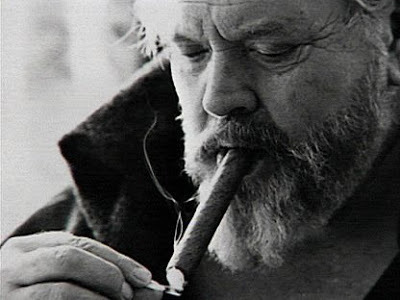
25. Conclusion: The Legacy of Orson Welles
We are now living in the greatest time to be an Orson Welles fan. The old truism is that artists are never appreciated until after they die but now in 2018 the full lot of his estranged filmography is finally starting to make its way into the public eye. Welles is beloved as one of the filmmakers in history and his work is regularly mentioned in the same breath as the masters like John Ford, Ingmar Bergman, Akira Kurosawa, and Jean Luc-Godard.
Every year the studios that own the rights to Welles' films go out of their way to restore and re-release more of his films. Just in the past few years The Criterion Collection has gone back and released Chimes at Midnight, The Immortal Story, Othello, Filming Othello and The Magnificent Ambersons on Blu-ray. Chimes at Midnight's release on home video coincided with its first public touring in the United States in decades as the film's restoration was displayed on dozens of movie theaters across the country in 2016. Citizen Kane, The Third Man, Touch of Evil and Macbeth all have excellent Blu-ray transfers. His lesser known and regarded films like The Stranger and The Trial are in the public domain and are available for free online.
It's a shame that the late director's work has for long been relegated to the dustbins of history. Many of his best pieces of film were left to rot for decades in vaults with no public viewing or demand. Now almost all of his work is available to buy on the most up to date home viewing format. Fans of cinema ought to seek these films out. Though obscure and often rough around the edges, Orson Welles produced one of the finest outputs of work in the history of cinema. He persisted against a lifetime of odds and gave the world everything he had in him until there was nothing left to give. In the end, he was a more modest, fragile and melancholy soul than the bombast, ego and strength of his personality let on.
As Jonathon Rosenbaum discussed in during our FVTV interview this November, once he'd met Welles in person he no longer fanaticized the idea of wanting to be him. Even so, Welles was everything he was sold to be. He was kind, intelligent if a bit rude but he was always himself.
Resources/Sources:
Previous GUG Reviews: Citizen Kane, The Other Side of the Wind
Documentaries: Magician: The Astonishing Life and Work of Orson Welles, The Battle Over Citizen Kane, They'll Love Me When I'm Dead, Filming Othello
Books: Citizen Kane: A Filmmaker's Journey by Harlan Lebo, Orson Welles' Last Film by Josh Karp, The Encyclopedia of Orson Welles by Chuck Berg and Tom Erskine
Video Essays: MovieBob: Citizen Unicron, Kyle Kalgreen: F for Fake, Kyle Kalgreen: Chimes at Midnight, Razorfist: The Third Man, Cinemologists: Mr. Arkadin
Online Researches: Wikipedia, When Radio Was
youtube
0 notes
Photo
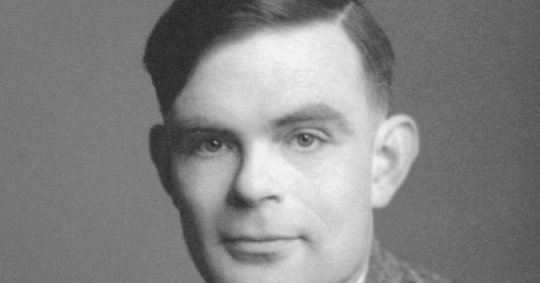
Overlooked No More: Alan Turing, Condemned Code Breaker and Computer Visionary https://nyti.ms/2XsJPxN

Overlooked is a series of obituaries about remarkable people whose deaths, beginning in 1851, went unreported in The Times. This month we’re adding the stories of important L.G.B.T.Q. figures.
By Alan Cowell
LONDON — His genius embraced the first visions of modern computing and produced seminal insights into what became known as “artificial intelligence.” As one of the most influential code breakers of World War II, his cryptology yielded intelligence believed to have hastened the Allied victory.
But, at his death several years later, much of his secretive wartime accomplishments remained classified, far from public view in a nation seized by the security concerns of the Cold War. Instead, by the narrow standards of his day, his reputation was sullied.
On June 7, 1954, Alan Turing, a British mathematician who has since been acknowledged as one the most innovative and powerful thinkers of the 20th century — sometimes called the progenitor of modern computing — died as a criminal, having been convicted under Victorian laws as a homosexual and forced to endure chemical castration. Britain didn’t take its first steps toward decriminalizing homosexuality until 1967.
Only in 2009 did the government apologize for his treatment.
“We’re sorry — you deserved so much better,” said Gordon Brown, then the prime minister. “Alan and the many thousands of other gay men who were convicted, as he was, under homophobic laws were treated terribly.”
And only in 2013 did Queen Elizabeth II grant Turing a royal pardon, 59 years after a housekeeper found his body at his home at Wilmslow, near Manchester, in northwest England.
A coroner determined that he had died of cyanide poisoning and that he had taken his own life “while the balance of his mind was disturbed.”
At his side lay a half-eaten apple. Biographers speculated that he had ingested the poison by dousing the apple with cyanide and eating it to disguise the toxin’s taste. Some of those who studied his personality or knew him, most notably his mother, Ethel Turing, challenged the official verdict of suicide, arguing that he had poisoned himself accidentally.
To this day Turing is recognized in his own country and among a broad society of scientists as a pillar of achievement who had fused brilliance and eccentricity, had moved comfortably in the abstruse realms of mathematics and cryptography but awkwardly in social settings, and had been brought low by the hostile society into which he was born.
“He was a national treasure, and we hounded him to his death,” said John Graham-Cumming, a computer scientist who campaigned for Turing to be pardoned.
Above all, Turing’s name is associated for many people with the top-secret wartime operations of Britain’s code-breakers at Bletchley Park, a sprawling estate north of London, where he oversaw and inspired the effort to decrypt ciphers generated by Nazi Germany’s Enigma machine, which had once seemed impenetrable. The Germans themselves regarded the codes as unbreakable.
At the time, German submarines were prowling the Atlantic, hunting Allied ships carrying vital cargo for the war effort. The convoys were critical for building military strength in Britain and eventually enabled the Allies to undertake the D-Day landings in Normandy in 1944, heralding the collapse of Nazi Germany the next year.
Only by charting the submarines’ movements could Allied forces change the course of their convoys, and for that they relied on the cryptologists of Bletchley Park to decode messages betraying the Germans’ deployments.
The enduring fascination with Turing’s story inspired the 2014 movie “The Imitation Game,” starring Benedict Cumberbatch and Keira Knightley. But his scientific range went far beyond the limits of cinematic drama: He laid down principles that have molded the historical record of the relationship between humans and the machines they have created to solve their problems.
Image
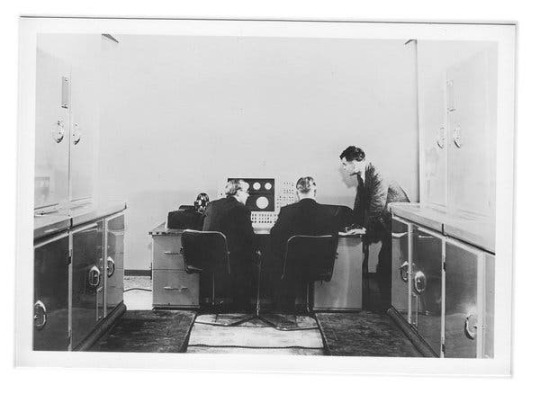
Turing and colleagues working on the Ferranti Mark I Computer in 1951. It was based on a prototype built five years earlier at the University of Manchester under the supervision of Professor Max Newman.CreditSSPL/Getty Images
Even before World War II, Turing was making breakthroughs.
Credit for the creation of the first functioning computer in 1946 went to the researchers John Presper Eckert and John W. Mauchly for their machine the Electronic Numerical Integrator and Computer, or Eniac, which they had developed at the University of Pennsylvania during World War II.
But Turing’s notions preceded the Eniac. He conceived what became known as the universal Turing machine, which envisioned “one machine for all possible tasks” — essentially computers as we know them today, Andrew Hodges, Turing’s biographer, wrote in a condensed version of his 1983 book, “Alan Turing: The Enigma.”
Turing’s vision, Hodges said, was that one machine could “be turned to any well-defined task by being supplied with the appropriate program.”
He added, “The universal Turing machine naturally exploits what was later seen as the ‘stored program’ concept essential to the modern computer: It embodies the crucial 20th century insight that symbols representing instructions are no different in kind from symbols representing numbers.”
Later, technology that emerged from the Manhattan Project, the United States-led effort to develop the atom bomb, also relied on Turing’s ideas.
“What had begun as a British idea was scaled up to industrial size by the Americans,” David Kaiser, a professor at the Massachusetts Institute of Technology, wrote in 2012 in The London Review of Books.
Turing’s postwar work at the University of Manchester, on the first functioning British computers, was also significant: It reflected the emerging power of electronic computing in the Cold War race for nuclear supremacy. And he remained fascinated by the interplay between human thought processes and their computerized inventions. Even in 1944, Hodges wrote, Turing had spoken to a colleague about “building a brain.”
Image
Benedict Cumberbatch as Turing in the 2014 movie “The Imitation Game.”
In an article published in 1950 in the academic journal Mind, Turing developed a method that came to be known as the “Turing Test,” a sort of thought experiment to determine whether a computer could pass as a human. As part of his experiment, a human interrogator would ask questions and try to figure out whether the answers had come from a computer or a human.
Many years later, on a visit to London, President Barack Obama placed Turing in a trans-Atlantic pantheon of innovation and discovery, saying, “From Newton and Darwin to Edison and Einstein, from Alan Turing to Steve Jobs, we have led the world in our commitment to science and cutting-edge research.”
Alan Mathison Turing was born in London on June 23, 1912, the second of two sons of Ethel Sara Stoney and Julius Mathison Turing, who had met in imperial India, where his father was a senior colonial administrator. After Alan’s birth they left him and his brother, John, in the care of foster parents in England while they returned to India so that Alan’s father could continue his work.
“Alan Turing’s story was not one of family or tradition but of an isolated and autonomous mind,” Hodges wrote.
In his early days, Turing’s education reflected the overwhelming social requisite of his class to secure a place at a reputable private boarding school. Alan, at age 13, enrolled at Sherborne School, in southern England, where his fascination with science raised alarms in an educational system based on the study of what were called the classics — works in Latin and ancient Greek.
“If he is to be solely a scientific specialist, he is wasting his time at a public school,” Nowell Smith, Sherborne’s headmaster, wrote to his parents, as recorded in Hodges’s book.
Image
A young Alan Turing sailing with classmates from King’s College in Cambridge, where he studied mathematics. He graduated in 1934 with a first class honors degree.CreditREX/Shutterstock
Nonetheless, he secured a place at King’s College in Cambridge to study mathematics, graduating in 1934 with a first class honors degree. With remarkable academic precocity he was made a fellow of the college in 1935. A year later, he published the groundbreaking paper “On Computable Numbers, With an Application to the Entscheidungsproblem” (or “decidability problem”), a reference in German to a celebrated riddle that the American logician Alonzo Church had also explained.
Both Turing and Church reached the same conclusion — a basis for computer science — that there is no single algorithm that could determine the truth or falsity of any statement in formal logic (though Turing’s thinking was more direct).
Turing completed a doctoral thesis at Princeton in 1938 before returning to Cambridge. With Britain’s declaration of war on Germany in September 1939, he joined the Bletchley Park code breakers at the Government Code and Cypher School, working in makeshift huts clustered around a mansion.
Their greatest initial challenge was figuring out the method of encryption of the German Enigma device, which was invented 20 years earlier by Arthur Scherbius, a German electrical engineer who had patented it as a civilian machine to encrypt commercial messages. The machine worked by entering letters on a typewriter-like keyboard and then encoding them through a series of rotors to a light board, which showed the coded equivalents. The machine was said to be capable of generating almost 159 quintillion permutations.
The British were helped initially by a Polish mathematician who had been studying the Enigma machine and had provided vital details after Hitler’s forces invaded Poland in 1939. But under the direction of Turing and another Cambridge-educated mathematician, W.G. Welchman, the Bletchley Park code breakers greatly expanded and accelerated those early efforts. Using a huge contraption called the Bombe, they mimicked the operations of the Enigma machine to break its codes.
Image
The back of a huge contraption known as the Bombe, which the Bletchley Park code breakers used to break ciphers created by Nazi Germany’s Enigma machine.CreditSSPL/Getty Images
“The critical factor was Turing’s brilliant mechanization of subtle logical deductions,” the biographer Hodges wrote.
In 1942, Turing was assigned to visit the United States for several months of high-level consultations on the encryption of conversations between President Franklin D. Roosevelt and Winston S. Churchill. His wartime work earned him a high civilian award, and he was named an Officer of the Most Excellent Order of the British Empire.
In the postwar years, Turing’s fascination with computers led him to design the Automatic Computing Engine. Although it was never built, Turing believed that “the computer would offer unlimited scope for practical progress toward embodying intelligence in an artificial form,” Hodges wrote.
In May 1948, Turing moved to Manchester University’s computing laboratory and bought a house in nearby Wilmslow. Among his enthusiasms were his work on various scientific themes, including morphogenesis, the theory of growth and form in biology; his continued secret ties to Britain’s postwar code breakers; and long-distance running.
He was also, Hodges said, beginning to explore the homosexual identity he had hidden when he proposed marriage in 1941 to Joan Clarke, a Bletchley Park cryptanalyst. He later withdrew the offer after explaining his sexuality to her, and the two remained friends.
About 10 years later, the police were investigating a burglary at his home when he admitted to having had a physical relationship with a man named Arnold Murray. Murray told Turing that he knew the thief’s identity, and detectives, in their questioning, asked Turing about his relationship to Murray.
In March 1952, Turing and Murray were charged with “gross indecency,” and both pleaded guilty in court. Murray was given a conditional discharge, but Turing was ordered to undergo chemical castration by taking doses of the female hormone estrogen to reduce sex drive.
Two years later, the motive for his apparent suicide, at age 41, remained unclear and left many questions. At the time, Hodges wrote, known homosexuals were denied security clearances, which meant that Turing could not be involved in secret work during the Cold War, leaving him excluded and embittered. While a coroner deemed the death a suicide, the telltale apple at Turing’s side was never forensically examined.
“Eccentric, solitary, gloomy, vivacious, resigned, angry, eager, dissatisfied — these had always been his ever-varying characteristics,” Hodges wrote, “and despite the strength that he showed the world in coping with outrageous fortune, no one could safely have predicted his future course.”
1 note
·
View note
Text
News and important updates on POS System Equipment & POS.
Scenes from The Searchers (1956), starring John Wayne and set during the Texas-Indian Wars. The film is considered one of the most influential Westerns ever made.
“It just so happens we be Texicans,” says Mrs. Jorgensen, an older woman wearing her blond hair in a tight bun, to rough-and-tumble cowboy Ethan Edwards in the 1956 film The Searchers. Mrs. Jorgensen, played by Olive Carey, and Edwards, played by John Wayne, sit on a porch facing the settling dusk sky, alone in a landscape that is empty as far as the eye can see: a sweeping desert vista painted with bright orange Technicolor. Set in 1868, the film lays out a particular telling of Texas history, one in which the land isn’t a fine or good place yet. But, with the help of white settlers willing to sacrifice everything, it’s a place where civilization will take root. Nearly 90 years after the events depicted in the film, audiences would come to theaters and celebrate those sacrifices.
“A Texican is nothing but a human man way out on a limb, this year and next. Maybe for 100 more. But I don’t think it’ll be forever,” Mrs. Jorgensen goes on. “Someday this country’s going to be a fine, good place to be. Maybe it needs our bones in the ground before that time can come.”
There’s a subtext in these lines that destabilizes the Western’s moral center, a politeness deployed by Jorgensen that keeps her from naming what the main characters in the film see as their real enemies: Indians.
In the film, the Comanche chief, Scar, has killed the Jorgensens’ son and Edwards’ family, and abducted his niece. Edwards and the rest of Company A of the Texas Rangers must find her. Their quest takes them across the most treacherous stretches of desert, a visually rich landscape that’s both glorious in its beauty and perilous given the presence of Comanche and other Indigenous people. In the world of the Western, brutality is banal, the dramatic landscape a backdrop for danger where innocent pioneers forge a civilization in the heart of darkness.
The themes of the Western are embodied by figures like Edwards: As a Texas Ranger, he represents the heroism of no-holds-barred policing that justifies conquest and colonization. While the real Texas Rangers’ history of extreme violence against communities of color is well-documented, in the film version, these frontier figures, like the Texas Rangers in The Searchers or in the long-running television show The Lone Ranger, have always been portrayed as sympathetic characters. Edwards is a cowboy with both a libertarian, “frontier justice” vigilante ethic and a badge that puts the law on his side, and stories in the Western are understood to be about the arc of justice: where the handsome, idealized male protagonist sets things right in a lawless, uncivilized land.
The Western has long been built on myths that both obscure and promote a history of racism, imperialism, toxic masculinity, and violent colonialism. For Westerns set in Texas, histories of slavery and dispossession are even more deeply buried. Yet the genre endures. Through period dramas and contemporary neo-Westerns, Hollywood continues to churn out films about the West. Even with contemporary pressures, the Western refuses to transform from a medium tied to profoundly conservative, nation-building narratives to one that’s truly capable of centering those long victimized and villainized: Indigenous, Latinx, Black, and women characters. Rooted in a country of contested visions, and a deep-seated tradition of denial, no film genre remains as quintessentially American, and Texan, as the Western, and none is quite so difficult to change.
*
With origins in the dime and pulp novels of the late 19th century, the Western first took to the big screen in the silent film era. The Great Train Robbery, a 1903 short, was perhaps the genre’s first celluloid hit, but 1939’s Stagecoach, starring Wayne, ushered in a new era of critical attention, as well as huge commercial success. Chronicling the perilous journey of a group of strangers riding together through dangerous Apache territory in a horse-drawn carriage, Stagecoach is widely considered to be one of the greatest and most influential Westerns of all time. It propelled Wayne to stardom.
During the genre’s golden age of the 1950s, more Westerns were produced than films of any other genre. Later in the 1960s, the heroic cowboy character—like Edwards in The Searchers—grew more complex and morally ambiguous. Known as “revisionist Westerns,” the films of this era looked back at cinematic and character traditions with a more critical eye. For example, director Sam Peckinpah, known for The Wild Bunch (1969), interrogated corruption and violence in society, while subgenres like spaghetti Westerns, named because most were directed by Italians, eschewed classic conventions by playing up the dramatics through extra gunfighting and new musical styles and creating narratives outside of the historical context. Think Clint Eastwood’s The Good, the Bad, and the Ugly (1966).
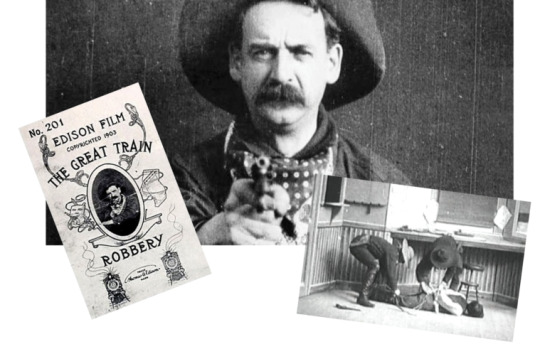
The Great Train Robbery (1903), a short silent film, was perhaps the first iconic Western.
In the wake of the anti-war movement and the return of the last U.S. combat forces from Vietnam in 1973, Westerns began to decline, replaced by sci-fi action films like Star Wars (1977). But in the 1990s, they saw a bit of rebirth, with Kevin Costner’s revisionist Western epic Dances With Wolves (1990) and Eastwood’s Unforgiven (1992) winning Best Picture at the Academy Awards. And today, directors like the Coen brothers (No Country for Old Men, True Grit) and Taylor Sheridan (Hell or High Water, Wind River, Sicario) are keeping the genre alive with neo-Westerns set in modern times.
Still, the Old West looms large, says cultural critic and historian Richard Slotkin. Today’s Western filmmakers know they are part of a tradition and take the task seriously, even the irreverent ones like Quentin Tarantino. Tarantino called Django Unchained (2012) a spaghetti Western and, at the same time, “a Southern.” Tarantino knows that the genre, like much of American film, is about violence, and specifically racialized violence: The film, set in Texas, Tennessee, and Mississippi, flips the script by putting the gun in the hand of a freed slave.
Slotkin has written a series of books that examine the myth of the frontier and says that stories set there are drawn from history, which gives them the authority of being history. “A myth is an imaginative way of playing with a problem and trying to figure out where you draw lines, and when it’s right to draw lines,” he says. But the way history is made into mythology is all about who’s telling the story.
Slotkin’s work purports that the logic of westward expansion is, when boiled down to its basic components, “regeneration through violence.” Put simply: Kill or die. The very premise of the settling of the West is genocide. Settler colonialism functions this way; the elimination of Native people is its foundation. It’s impossible to talk about the history of the American West and of Texas without talking about violent displacement and expropriation.
“The Western dug its own hole,” says Adam Piron, a film programmer at the Sundance Indigenous Institute and a member of the Kiowa and Mohawk tribes. In his view, the perspectives of Indigenous people will always be difficult to express through a form tied to the myth of the frontier. Indigenous filmmakers working in Hollywood who seek to dismantle these representations, Piron says, often end up “cleaning somebody else’s mess … And you spend a lot of time explaining yourself, justifying why you’re telling this story.”
While the Western presents a highly manufactured, racist, and imperialist version of U.S. history, in Texas, the myth of exceptionalism is particularly glorified, perpetuating the belief that Texas cowboys, settlers, and lawmen are more independent, macho, and free than anywhere else. Texas was an especially large slave state, yet African Americans almost never appear in Texas-based Westerns, a further denial of histories. In The Searchers, Edwards’ commitment to the white supremacist values of the South is even stronger than it is to the state of Texas, but we aren’t meant to linger on it. When asked to make an oath to the Texas Rangers, he replies: “I figure a man’s only good for one oath at a time. I took mine to the Confederate States of America.” The Civil War scarcely comes up again.
The Texas Ranger is a key figure in the universe of the Western, even if Ranger characters have fraught relationships to their jobs, and the Ranger’s proliferation as an icon serves the dominant Texas myth. More than 300 movies and television series have featured a Texas Ranger. Before Chuck Norris’ role in the TV series Walker, Texas Ranger (1993-2001), the most famous on-screen Ranger was the titular character of The Lone Ranger (1949-1957). Tonto, his Potawatomi sidekick, helps the Lone Ranger fight crime in early settled Texas.
Meanwhile, the Ranger’s job throughout Texas history has included acting as a slave catcher and executioner of Native Americans. The group’s reign of terror lasted well into the 20th century in Mexican American communities, with Rangers committing a number of lynchings and helping to dispossess Mexican landowners. Yet period dramas like The Highwaymen (2019), about the Texas Rangers who stopped Bonnie and Clyde, and this year’s ill-advised reboot of Walker, Texas Ranger on the CW continue to valorize the renowned law enforcement agency. There is no neo-Western that casts the Texas Ranger in a role that more closely resembles the organization’s true history: as a villain.

The Coen brothers’ No Country for Old Men (2007) ushered in the era of neo-Westerns set in modern times.
Ushered in by No Country for Old Men (2007), also set in Texas, the era of neo-Westerns has delivered films that take place in a modern, overdeveloped, contested West. Screenwriter Taylor Sheridan’s projects attempt to address racialized issues around land and violence, but they sometimes fall into the same traps as older, revisionist Westerns—the non-white characters he seeks to uplift remain on the films’ peripheries. In Wind River (2017), the case of a young Indigenous woman who is raped and murdered is solved valiantly by action star Jeremy Renner and a young, white FBI agent played by Elizabeth Olsen. Sheridan’s attempt to call attention to the epidemic of missing and murdered Indigenous women still renders Indigenous women almost entirely invisible behind the images of white saviors.
There are directors who are challenging the white male gaze of the West, such as Chloé Zhao, whose recent film Nomadland dominated the 2021 Academy Award nominations. In 2017, Zhao’s film The Rider centered on a Lakota cowboy, a work nested in a larger cultural movement in the late 2010s that highlighted the untold histories of Native cowboys, Black cowboys, and vaqueros, historically Mexican cowboys whose ranching practices are the foundation of the U.S. cowboy tradition. And Concrete Cowboy, directed by Ricky Staub and released on Netflix in April, depicts a Black urban horse riding club in Philadelphia. In taking back the mythology of the cowboy, a Texas centerpiece and symbol, perhaps a new subgenre of the Western is forming.
Despite new iterations, the Western has not been transformed. Still a profoundly patriotic genre, the Western is most often remembered for its classics, which helped fortify the historical narrative that regeneration through violence was necessary for the forging of a nation. In Texas, the claim made by Mrs. Jorgensen in The Searchers remains a deeply internalized one: The history of Texas is that of a land infused with danger, a land that required brave defenders, and a land whose future demanded death to prosper.
In Westerns set in the present day, it feels as if the Wild West has been settled but not tamed. Americans still haven’t learned how to live peacefully on the land, respect Indigenous people, or altogether break out of destructive patterns of domination. The genre isn’t where most people look for depictions of liberation and inclusion in Texas. Still, like Texas, the Western is a contested terrain with an unclear future. John Wayne’s old-fashioned values are just one way to be; the Western is just one way of telling our story.
This article was first provided on this site.
We hope you found the article above of help and/or of interest. Similar content can be found on our main site: southtxpointofsale.com
Please let me have your feedback below in the comments section.
Let us know what topics we should write about for you in the future.
youtube
#Point of Sale#harbortouch Lighthouse#harbortouch Pos#lightspeed Restaurant#point of sale#shopkeep Reviews#shopkeep Support#toast Point Of Sale#toast Pos Pricing#toast Pos Support#touchbistro Pos
0 notes